财务管理课后习题答案第7章
- 格式:doc
- 大小:104.50 KB
- 文档页数:7
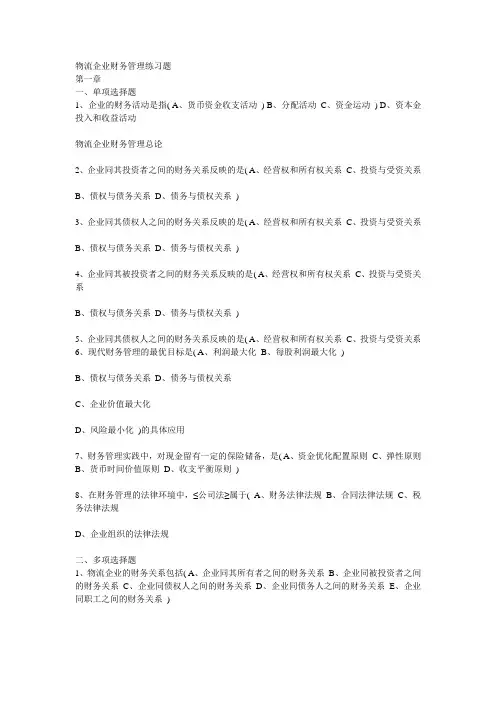
物流企业财务管理练习题第一章一、单项选择题1、企业的财务活动是指( A、货币资金收支活动) B、分配活动C、资金运动) D、资本金投入和收益活动物流企业财务管理总论2、企业同其投资者之间的财务关系反映的是( A、经营权和所有权关系C、投资与受资关系B、债权与债务关系D、债务与债权关系)3、企业同其债权人之间的财务关系反映的是( A、经营权和所有权关系C、投资与受资关系B、债权与债务关系D、债务与债权关系)4、企业同其被投资者之间的财务关系反映的是( A、经营权和所有权关系C、投资与受资关系B、债权与债务关系D、债务与债权关系)5、企业同其债权人之间的财务关系反映的是( A、经营权和所有权关系C、投资与受资关系6、现代财务管理的最优目标是( A、利润最大化B、每股利润最大化)B、债权与债务关系D、债务与债权关系C、企业价值最大化D、风险最小化)的具体应用7、财务管理实践中,对现金留有一定的保险储备,是( A、资金优化配置原则C、弹性原则B、货币时间价值原则D、收支平衡原则)8、在财务管理的法律环境中,≤公司法≥属于( A、财务法律法规B、合同法律法规C、税务法律法规D、企业组织的法律法规二、多项选择题1、物流企业的财务关系包括( A、企业同其所有者之间的财务关系B、企业同被投资者之间的财务关系C、企业同债权人之间的财务关系D、企业同债务人之间的财务关系E、企业同职工之间的财务关系)2、财务管理环境涉及的范围很广,其中最主要的是( A、金融市场环境B、经济环境C、法律环境) D、自然环境) E、国际环境3、广义的金融市场是批一切资本流动的场所,其交易包括( A、有价证券的买卖D、黄金和外汇的买卖B、票据承兑和贴现E、货币借贷) C、生产资料的产权交换4、金融市场对企业理财的作用表现为( A、金融市是企业筹资和投资的场所B、企业通过金融市场可以根据自身运营的需要进行长短期资金的相互转化C、金融市场为企业的财务管理活动提供各种金融服务,降低了企业理财的成本D、为企业相应空间内自主经营提供了法律上的保护E、金融市场可以为企业理财提供相关的信息5、与企业财务管理有关的经济方面的法律法规包括( A、企业组织的法律法规D、财务法律法规B、合同法律法规) C、税务法律法规E、全国统一的≤企业会计制度≥ ) D、企业内部整改E、汇率变化6、影响企业财务管理的宏观经济因素有( A、经济周期B、通货膨胀C、政府的经济政策)B、弹性原则E、收支平衡原则7、财务管理的原则一般包括( A、资金优化配置原则D、货币时间价值原则C、收益与风险均衡原则三、填空题1、企业的财务活动包括、、四个方面2、财务管理是指根据财经法规制度、运用特定的量化分析方法,组织企业的处理的一项经济管理工作、市场、、和市场和。
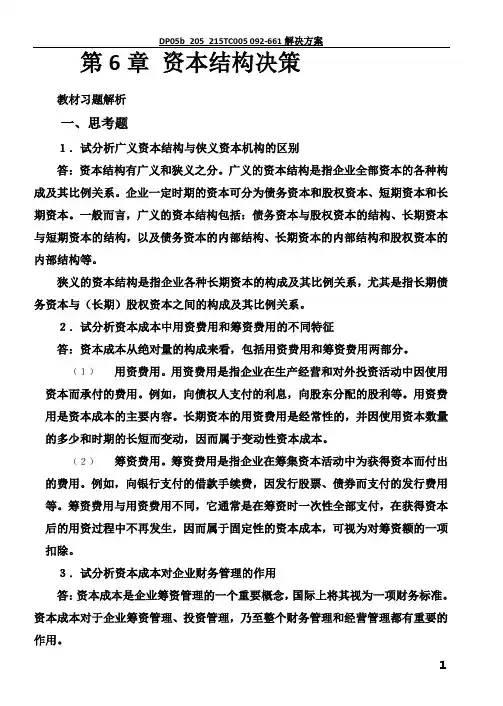
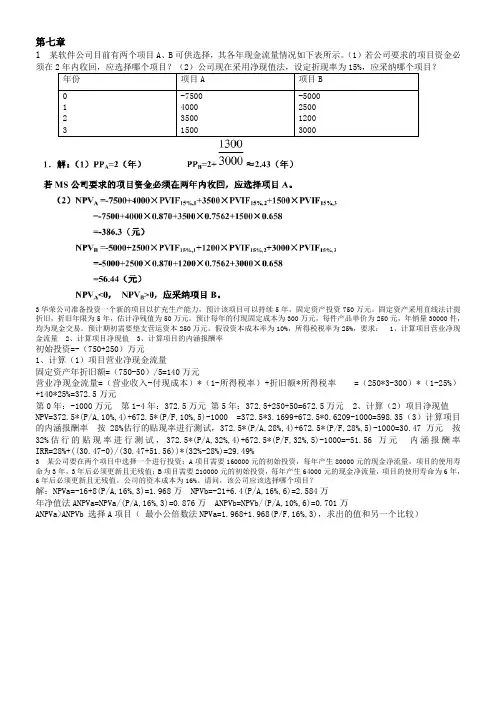
第七章1某软件公司目前有两个项目A、B可供选择,其各年现金流量情况如下表所示。
(1)若公司要求的项目资金必须在2年内收回,应选择哪个项目?(2)公司现在采用净现值法,设定折现率为15%,应采纳哪个项目?年份项目A 项目B0 1 2 3 -7500400035001500-50002500120030003华荣公司准备投资一个新的项目以扩充生产能力,预计该项目可以持续5年,固定资产投资750万元。
固定资产采用直线法计提折旧,折旧年限为5年,估计净残值为50万元。
预计每年的付现固定成本为300万元,每件产品单价为250元,年销量30000件,均为现金交易。
预计期初需要垫支营运资本250万元。
假设资本成本率为10%,所得税税率为25%,要求:1、计算项目营业净现金流量2、计算项目净现值3、计算项目的内涵报酬率初始投资=-(750+250)万元1、计算(1)项目营业净现金流量固定资产年折旧额=(750-50)/5=140万元营业净现金流量=(营业收入-付现成本)*(1-所得税率)+折旧额*所得税率=(250*3-300)*(1-25%)+140*25%=372.5万元第0年:-1000万元第1-4年:372.5万元第5年:372.5+250+50=672.5万元2、计算(2)项目净现值NPV=372.5*(P/A,10%,4)+672.5*(P/F,10%,5)-1000 =372.5*3.1699+672.5*0.6209-1000=598.35(3)计算项目的内涵报酬率按28%估行的贴现率进行测试,372.5*(P/A,28%,4)+672.5*(P/F,28%,5)-1000=30.47万元按32%估行的贴现率进行测试,372.5*(P/A,32%,4)+672.5*(P/F,32%,5)-1000=-51.56万元内涵报酬率IRR=28%+((30.47-0)/(30.47+51.56))*(32%-28%)=29.49%3 某公司要在两个项目中选择一个进行投资:A项目需要160000元的初始投资,每年产生80000元的现金净流量,项目的使用寿命为3年,3年后必须更新且无残值;B项目需要210000元的初始投资,每年产生64000元的现金净流量,项目的使用寿命为6年,6年后必须更新且无残值。
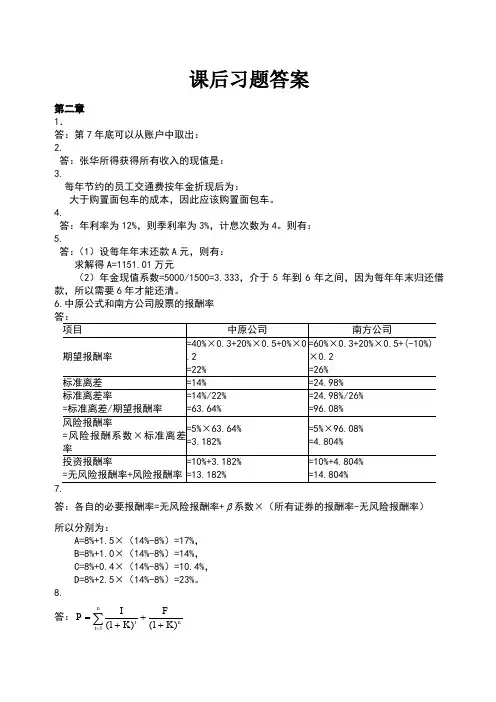
课后习题答案第二章 1.答:第7年底可以从账户中取出: 2.答:张华所得获得所有收入的现值是: 3.每年节约的员工交通费按年金折现后为:大于购置面包车的成本,因此应该购置面包车。
4.答:年利率为12%,则季利率为3%,计息次数为4。
则有: 5. 答:(1)设每年年末还款A 元,则有:求解得A=1151.01万元(2)年金现值系数=5000/1500=3.333,介于5年到6年之间,因为每年年末归还借款,所以需要6年才能还清。
6.中原公式和南方公司股票的报酬率 答: 项目 中原公司 南方公司期望报酬率 =40%×0.3+20%×0.5+0%×0.2 =22% =60%×0.3+20%×0.5+(-10%)×0.2=26%标准离差 =14% =24.98% 标准离差率 =标准离差/期望报酬率 =14%/22% =63.64% =24.98%/26% =96.08% 风险报酬率=风险报酬系数×标准离差率=5%×63.64% =3.182% =5%×96.08%=4.804%投资报酬率 =无风险报酬率+风险报酬率 =10%+3.182% =13.182% =10%+4.804% =14.804% 7.答:各自的必要报酬率=无风险报酬率+β系数×(所有证券的报酬率-无风险报酬率) 所以分别为:A=8%+1.5×(14%-8%)=17%, B=8%+1.0×(14%-8%)=14%, C=8%+0.4×(14%-8%)=10.4%, D=8%+2.5×(14%-8%)=23%。
8. 答:nnt t K FK I P )1()1(1+++=∑=则该债券价格小于899.24元时,才能进行投资。
9.答:(1)计算各方案的期望报酬率、标准离差:项目 A B C期望报酬率=0.2×25%+0.4×20%+0.4×15%=19%=0.2×25%+0.4×10%+0.4×20%=17%=0.2×10%+0.4×15%+0.4×20%=16%标准离差=3.74% =6% =3.74%(2)50%的A证券和50%的B证券构成的投资组合:22225%18%0.2+15%18%0.4+17.5%18%0.4=3.67%-⨯-⨯-⨯标准离差()()()(3)50%的A证券和50%的C证券构成的投资组合:22217.5%17.5%0.2+17.5%17.5%0.4+17.5%17.5%0.4=0-⨯-⨯-⨯标准离差()()()(4)50%的B证券和50%的C证券构成的投资组合:第四章 1.解:每年折旧=(140+100)?4=60(万元)每年营业现金流量=营业收入?(1?税率)?付现成本?(1?税率)+折旧?税率=220?(1?25%)?110?(1?25%)+60?25% =165?82.5+15=97.5(万元) 投资项目的现金流量为:年份 0 1 2 3 4 5 6 初始投资 垫支流动资金 营业现金流量 收回流动资金?140 ?100 ?40 97.5 97.5 97.5 97.5 40 (1)净现值=40?PVIF 10%,6+97.5?PVIFA 10%,4?PVIF 10%,2?40? PVIF 10%,2?100? PVIF 10%,1?140 =40?0.564+97.5?3.170?0.826?40?0.826?100?0.909?140 =22.56+255.30?33.04?90.9?140=13.92(万元)(2)获利指数=(22.56+255.30?33.04)/(90.9+140)=1.06 (3)贴现率为11%时:净现值=40?PVIF 11%,6+97.5?PVIFA 11%,4?PVIF 11%,2?40? PVIF 11%,2?100? PVIF 11%,1?140 =40?0.535+97.5?3.102?0.812?40?0.812?100?0.901?140 =21.4+245.59?32.48?90.1?140=4.41(万元)贴现率为12%时:净现值=40?PVIF 12%,6+97.5?PVIFA 12%,4?PVIF 12%,2?40? PVIF 12%,2?100? PVIF 12%,1?140 =40?0.507+97.5?3.037?0.797?40?0.797?100?0.893?140 =20.28+236?31.88?89.3?140= - 4.9(万元) 设内部报酬率为r ,则:9.441.4%11%1241.4%11+-=-rr=11.47%综上,由于净现值大于0,获利指数大于1,贴现率大于资金成本10%,故项目可行。
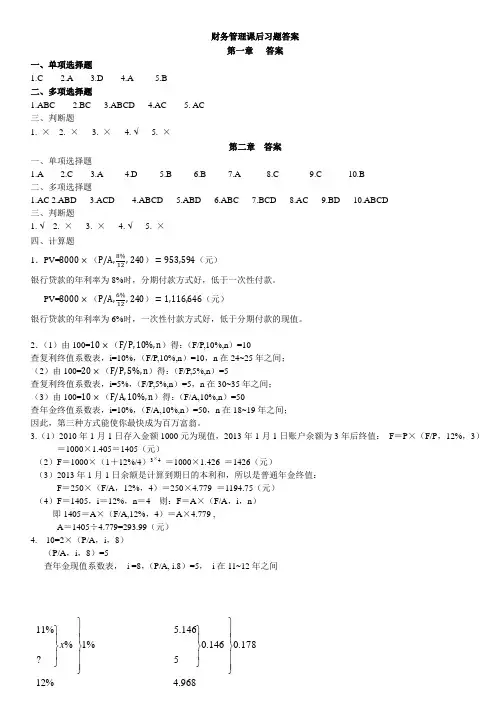
财务管理课后习题答案第一章 答案一、单项选择题1.C2.A3.D4.A5.B 二、多项选择题1.ABC2.BC3.ABCD4.AC5. AC 三、判断题1. ×2. ×3. ×4. √5. ×第二章 答案一、单项选择题1.A2.C3.A4.D5.B6.B7.A8.C9.C 10.B 二、多项选择题1.AC2.ABD3.ACD4.ABCD5.ABD6.ABC7.BCD8.AC9.BD 10.ABCD 三、判断题1. √2. ×3. ×4. √5. × 四、计算题1.PV=8000×(P/A,8%12,240)=953,594(元)银行贷款的年利率为8%时,分期付款方式好,低于一次性付款。
PV=8000×(P/A,6%12,240)=1,116,646(元)银行贷款的年利率为6%时,一次性付款方式好,低于分期付款的现值。
2.(1)由100=10×(F/P,10%,n )得:(F/P,10%,n )=10 查复利终值系数表,i=10%,(F/P,10%,n )=10,n 在24~25年之间; (2)由100=20×(F/P,5%,n )得:(F/P,5%,n )=5 查复利终值系数表,i=5%,(F/P,5%,n )=5,n 在30~35年之间;(3)由100=10×(F/A,10%,n )得:(F/A,10%,n )=50 查年金终值系数表,i=10%,(F/A,10%,n )=50,n 在18~19年之间; 因此,第三种方式能使你最快成为百万富翁。
3.(1)2010年1月1日存入金额1000元为现值,2013年1月1日账户余额为3年后终值: F =P ×(F/P ,12%,3)=1000×1.405=1405(元)(2)F =1000×(1+12%/4)3×4 =1000×1.426 =1426(元)(3)2013年1月1日余额是计算到期日的本利和,所以是普通年金终值:F =250×(F/A ,12%,4)=250×4.779 =1194.75(元) (4)F =1405,i =12%,n =4 则:F =A ×(F/A ,i ,n ) 即1405=A ×(F/A,12%,4)=A ×4.779 ,A =1405÷4.779=293.99(元) 4. 10=2×(P/A ,i ,8) (P/A ,i ,8)=5查年金现值系数表, i =8,(P/A, i.8)=5, i 在11~12年之间178.0146.0146.5%1%%11⎪⎪⎫⎪⎫⎪⎪⎫⎪⎫x2021 得,借款利率为11.82%5.递延年金现值P =300×(P/A ,10%,5)×(P/F ,10%,2)=300×3.791×0.826=939.4098(万元)。
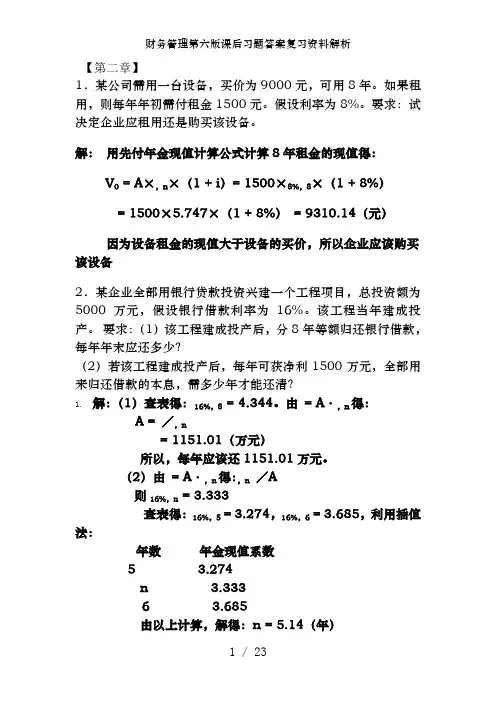
【第二章】1.某公司需用一台设备,买价为9000元,可用8年。
如果租用,则每年年初需付租金1500元。
假设利率为8%。
要求:试决定企业应租用还是购买该设备。
解:用先付年金现值计算公式计算8年租金的现值得:V0 = A×,n×(1 + i)= 1500×8%,8×(1 + 8%)= 1500×5.747×(1 + 8%)= 9310.14(元)因为设备租金的现值大于设备的买价,所以企业应该购买该设备2.某企业全部用银行贷款投资兴建一个工程项目,总投资额为5000万元,假设银行借款利率为16%。
该工程当年建成投产。
要求:(1)该工程建成投产后,分8年等额归还银行借款,每年年末应还多少?(2)若该工程建成投产后,每年可获净利1500万元,全部用来归还借款的本息,需多少年才能还清?1.解:(1)查表得:16%,8 = 4.344。
由= A·,n得:A = /,n= 1151.01(万元)所以,每年应该还1151.01万元。
(2)由= A·,n得:,n/A则16%,n = 3.333查表得:16%,5 = 3.274,16%,6 = 3.685,利用插值法:年数年金现值系数5 3.274n 3.3336 3.685由以上计算,解得:n = 5.14(年)所以,需要5.14年才能还清贷款。
3.银风汽车销售公司针对售价为25万元的A 款汽车提供两种促销方案。
a 方案为延期付款业务,消费者付现款10万元,余款两年后付清。
b 方案为商业折扣,银风汽车销售公司为全款付现的客户提供3%的商业折扣。
假设利率为10%,消费者选择哪种方案购买更为合算?方案a 的现值10+15*(,10%,2)=10+15/((10+10%)^2)=22.40万元方案b 的现值=25*(1-3%)=24.25万元因为方案a 现值<方案b 现值,所以,选择a 方案更合算4.李东今年20岁,距离退休还有30年。
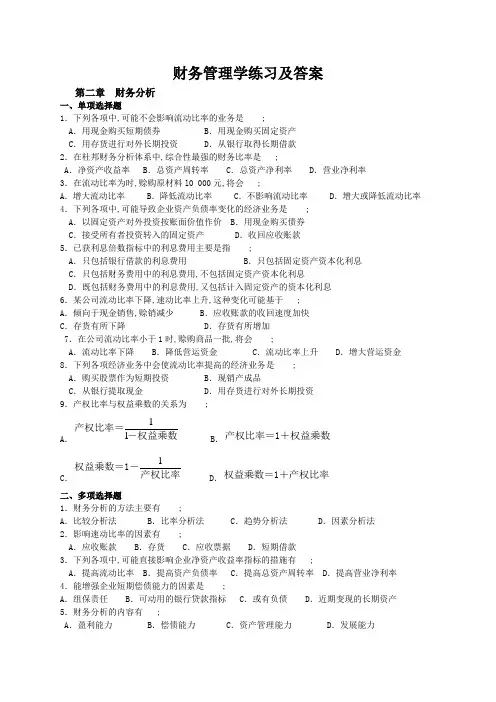
财务管理学练习及答案第二章财务分析一、单项选择题1.下列各项中,可能不会影响流动比率的业务是 ;A.用现金购买短期债券 B.用现金购买固定资产C.用存货进行对外长期投资 D.从银行取得长期借款2.在杜邦财务分析体系中,综合性最强的财务比率是 ;A.净资产收益率 B.总资产周转率 C.总资产净利率 D.营业净利率3.在流动比率为时,赊购原材料l0 000元,将会 ;A.增大流动比率 B.降低流动比率 C.不影响流动比率 D.增大或降低流动比率4.下列各项中,可能导致企业资产负债率变化的经济业务是 ;A.以固定资产对外投资按账面价值作价 B.用现金购买债券C.接受所有者投资转入的固定资产 D.收回应收账款5.已获利息倍数指标中的利息费用主要是指 ;A.只包括银行借款的利息费用 B.只包括固定资产资本化利息C.只包括财务费用中的利息费用,不包括固定资产资本化利息D.既包括财务费用中的利息费用,又包括计入固定资产的资本化利息6.某公司流动比率下降,速动比率上升,这种变化可能基于 ;A.倾向于现金销售,赊销减少 B.应收账款的收回速度加快C.存货有所下降 D.存货有所增加7.在公司流动比率小于1时,赊购商品一批,将会 ;A.流动比率下降 B.降低营运资金 C.流动比率上升 D.增大营运资金8.下列各项经济业务中会使流动比率提高的经济业务是 ;A.购买股票作为短期投资 B.现销产成品C.从银行提取现金 D.用存货进行对外长期投资9.产权比率与权益乘数的关系为 ;A.11产权比率=-权益乘数 B.产权比率=1+权益乘数C.1权益乘数=1-产权比率 D.权益乘数=1+产权比率二、多项选择题1.财务分析的方法主要有 ;A.比较分析法 B.比率分析法 C.趋势分析法 D.因素分析法2.影响速动比率的因素有 ;A.应收账款 B.存货 C.应收票据 D.短期借款3.下列各项中,可能直接影响企业净资产收益率指标的措施有 ;A.提高流动比率 B.提高资产负债率 C.提高总资产周转率 D.提高营业净利率4.能增强企业短期偿债能力的因素是 ;A.组保责任 B.可动用的银行贷款指标 C.或有负债 D.近期变现的长期资产5.财务分析的内容有 ;A.盈利能力 B.偿债能力 C.资产管理能力 D.发展能力6.在其他条件不变的情况下,会引起总资产周转率指标上升的经济业务是 ;A.用现金偿还负债 B.用银行存款购入一台设备C.借入一笔短期借款 D.用银行存款支付一年的报刊订阅费7.某公司当年的经营利润很多,却不能偿还到期债务;应检查的财务比率包括 ;A.资产负债率 B.流动比率 C.速动比率 D.应收账款周转率8.影响总资产净利率的因素有 ;A.资产平均总额 B.利息支出 C.净利润 D.权益乘数9.若公司流动比率过高,可能由情况所导致;A.产品滞销 B.应收账款增多 C.待摊费用增加 D.待处理财产损失增加l0.沃尔评分法的缺点有 ;A.选定的指标缺乏证明力 B.不能对企业的信用水平做出评价C.不能确定总体指标的累计分数D.指标严重异常时,对总评分产生不合逻辑的影响三、判断题1.因素分析法中各因素替代顺序是:先质量后数量;先实物量后货币量;先主要后次要;先基础后派生;2.当资金收益率高于债务利息率时,债务比例的增加对投资者是有利的;3.趋势分析法只能用于同一企业不同时期财务状况的纵向比较,而不能用于不同企业之间的横向比较;4.权益乘数的高低取决于企业的资金结构:资产负债率越高,权益乘数越高,财务风险越大; 5.产权比率侧重于揭示财务结构的稳健程度以及自有资金对偿债风险的承受能力;6.或有负债可能增强企业的偿债能力;7.在进行已获利息倍数对指标的同行业比较分析时,从稳健的角度出发,应以本企业该指标最高的年度数据作为分析依据;8.权益净利率是评价企业自有资本及其积累获取报酬水平的最具综合性与代表性的指标,其适用范围广,但受行业局限;9.某公司今年与上年相比,主营业务收入净额增长10%,净利润增长8%,资产总额增加12%,负债总额增加9%;可以判断,该公司净资产收益率比上年下降了;10.市盈率是评价上市公司盈利能力的指标,它反映投资者愿意对公司每股净利润支付的价格;一、单项选择题:1. A 2. A 3. B 4. C 5. D 6. C 7. C 8. B 9. D二、多项选择题:1. ABCD 2. ACD 3. BCD 4. BD 5. ABCD 6. AD 7. BCD 8. AC9. ABCD l0. AD三、判断题:1.× 2.√ 3.× 4.√ 5.√ 6.× 7.×8.× 9.√ 10.√第三章财务管理的基本观念一、单项选择题1.货币的时间价值是一种的结果;A.自然增值B.使用权转移C.投资和再投资D.所有权转移2.预付年金现值系数与普通年金现值系数的不同之处在于 ;A.期数要减1B.系数要加1C.期数要减1,系数要加1D. 期数要加1,系数要减13.在期望值相同的情况下,标准离差越大的方案其风险 ;A.越大B.越小C.二者无关D.无法判断4.财务风险是带来的风险;A.通货膨胀B.高利率C.筹资决策D.销售决策5.风险报酬是指投资者因冒风险进行投资而获得的 ;A.利润B.额外报酬C.利息D.利益6.标准离差是各种可能的报酬率偏离的综合差异;A.期望报酬率B.概率C.风险报酬率D.实际报酬率7.投资项目的风险报酬率取决于全体投资者对风险的态度;若投资者都愿冒风险投资,则风险报酬率就 ;A.大B.等于零C.小D.不确定二、多项选择题1.影响货币时间价值大小的因素主要包括 ;A.单利B.复利C.资金额D.利率E.期限2.下列各项中,属于普通年金形式的项目有 ;A.零存整取储蓄存款的整取额B.定期定额支付的养老金C.年资本回收额D.偿债基金E.支付优先股的股利3.下列表述中,正确的有 ;A.复利终值系数和复利现值系数互为倒数B.普通年金终值系数和普通年金现值系数互为倒数C.普通年金终值系数和偿债基金系数互为倒数D.普通年金现值系数和投资回收系数互为倒数E.预付年金现值系数和预付年金终值系数互为倒数4.在财务管理中,经常用来衡量风险大小的指标有 ;A.标准离差B.边际成本C.风险报酬率D.贡献毛益E.标准离差率5.从单个公司本身来看,风险分为 ;A.市场风险B.财务风险C.经营风险D.外汇风险E.交易风险三、判断题1.一般说来,资金时间价值是指没有通货膨胀条件下的投资报酬率;2.递延年金终值的大小与递延期无关,故计算方法和普通年金终值是一样的;3.名义利率指一年内多次复利时给出的年利率,它等于每期利率与年内复利次数的乘积;4.对于多个投资方案而言,无论各方案的期望值是否相同,标准离差率最大的方案一定是风险最大的方案;5.国库券是一种几乎没有风险的有价证券;其利率可以代表资金时间价值;6.根据风险于收益对等原理,高风险的投资项目必然会获得高收益;一、单项选择题:二、多项选择题:三、判断题:1.× 2.√ 3.√ 4.√ 5.× 6.×第四章证券估值一、单项选择题:1. 购买平价发行的每年付息一次的债券,其到期收益率和票面利率 ;A.前者大于后者 B.后者大于前者 C.无关系 D.相等2. 以下投资项目中,风险最大的是 ;A.国库券 B.银行存款 C.股票 D.公司债券3. 债券期限越长,其利率风险 ;A.越小 B.越大 C.为零 D.无法确定二、多项选择题:1.长期债券收益率高于短期债券收益率,这是因为 ;A.长期债券持有时间长,难以避免通货膨胀影响 B.长期债券流动性差C.长期债券面值高 D.长期债券不记名2.债券投资人的实际利息收入取决于 ;A.债券面值 B.票面利率 C.债券持有期 D.计息方式及债券到期日3.股票未来现金流入的现值,被称为股票的 ;A.市值 B.面值 C.内在价值 D.理论价值三、判断题:1.到期收益率反映的是债券投资人按复利计算的真实收益率;若高于投资人要求的投资收益率,则应买进债券;2.进行债券收益水平评价时,可不考虑资金时间价值;3.利率固定的有价证券没有利率风险;4.证券市场上所有投资项目,其风险都与预期报酬率成正比;5.固定利率债券比浮动利率债券承担更大的利率风险;一、单项选择题:二、多项选择题:三、判断题:1.√ 2.× 3.× 4.√ 5.√第五章财务预测与财务预算一、单项选择题:1. 企业的外部融资需求的正确估计为 ;A.资产增加-预计总负债-预计股东权益B.资产增加-负债自然增加-留存收益的增加C.预计总资产-负债自然增加-留存收益的增加D.预计总资产-负债自然增加-预计股东权益增加2.与生产预算没有直接联系的预算是;A.直接材料预算B.变动制造费用预算C.销售及管理费用预算D.直接人工预算3.企业的全面预算体系以作为终结;A.销售预算 B.现金预算 C.预计财务报表 D.资本支出预算4. 属于编制全面预算的出发点的是 ;A.销售预算 B.生产预算 C.现金预算 D.预计利润表5.下列各项中,不能直接在现金预算中得到反映的是 ;A.期初现金余额 B.现金筹措情况 C.现金收支情况 D.产销量情况6.下列各项中,没有直接在现金预算中得到反映的是 ;A.期初期末现金余额B.现金筹措及运用C.预算期产量和销量D.预算期现金余缺二、多项选择题:1.企业若打算减少外部融资的数量,应该 ;A.提高销售利润率 B.提高股利支付率 C.降低股利支付率 D.提高销售量2.编制预计财务报表的编制基础包括 ;A.生产预算 B.销售预算 C.资本支出预算 D.制造费用预算3.编制生产预算中的“预计生产量”项目时,需要考虑的因素有 ;A.预计销售量 B.预计期初存货 C.预计期末存货 D.前期实际销量 E.生产需用量4.产品成本预算,是预算的汇总;A.生产 B.直接材料 C.直接人工 D.制造费用5.下列各项中,被纳入现金预算的有 ;A.税金的缴纳 B.现金盈余或不足 C.现金收入 D.股利和利息支出6.与生产预算有直接联系的预算是 ;A.直接材料预算B.变动制造费用预算C.销售及管理费用预算D.直接人工预算三、判断题:1.制造费用预算分为变动制造费用和固定制造费用两部分;变动制造费用和固定制造费用均以生产预算为基础来编制;2. “现金预算”中的“所得税现金支出”项目,要与“预计利润表”中的“所得税”项目的金额一致;它是根据预算的“利润总额”和预计所得税率计算出来的,一般不必考虑纳税调整事项;3.管理费用多属于固定成本,所以,管理费用预算一般是以过去的实际开支为基础,按预算期的可预见变化来调整;4.生产预算是规定预算期内有关产品生产数量、产值和品种结构的一种预算;5.制造费用预算是根据生产预算为基础来编制的;6.生产预算是只以实物量作为计量单位的预算;一、单项选择题:二、多项选择题:三、判断题:1.╳ 2. ╳ 3. √ 4. ╳ 5. ╳ 6. √第六章投资管理一、单项选择题:1.投资项目使用企业原有的非货币资产,其相关的现金流量应为非货币资产的A.帐面价值 B.变现价值 C.折余价值 D.原始价值2. 计算投资方案的增量现金流量时,需考虑的成本是 ;A.沉没成本 B.历史成本 C.重置成本 D.帐面成本3. 如果考虑货币的时间价值,固定资产年平均成本是未来使用年限内现金流出总现值与的比值;A.年金现值系数 B.年金终值系数 C.回收系数 D.偿债系数4. 下列项目不引起现金流出的是 ;A.支付材料款 B.支付工资 C.垫支流动资金 D.计提折旧5. 在进行项目风险分析时,易夸大远期现金流量风险的方法是 ;A.净现值法 B.内含报酬率法 C.风险调整贴现率法 D.肯定当量系数法二、多项选择题:1.投资方案评价指标中,考虑了时间价值因素的有 ;A.会计收益率 B.回收期 C.净现值 D.内部报酬率 E.现值指数2.某一投资方案的净现值大于零,则意味着该方案 ;A.贴现后现金流入大于现金流出 B.贴现后现金流入小于现金流出C.报酬率大于预定的贴现率 D.报酬率小于预定的贴现率3.关于投资项目营业现金流量预计,以下做法正确的有 ;A.营业现金流量等于税后净利加折旧B.营业现金流量等于营业收入减去付现成本再减去所得税C.营业现金流量等于税后收入减去税后成本再加上折旧引起的税负减少额D.营业现金流量等于税后收入减去税后成本再加上折旧三、判断题:1.对于投资方案来说,只有增量现金流才是相关现金流量;2.一个企业能否维持下去,不取决于是否有足够的现金满足各种支付,而关键是看其是否盈利;3.投资项目评价所用的内部报酬率指标,其指标的计算与项目预定的贴现率高低有直接关系;4.肯定当量系数是指不肯定的1元现金流量期望值相当于使投资者满意的肯定金额的系数;5.设备更新决策中,若新旧设备未来使用年限不同,则不宜采用净现值法和内部报酬率法;一、单项选择题:二、多项选择题:三、判断题:1.√ 2.× 3.× 4.√ 5.√第七章流动资金管理一、单项选择题1.下列现金管理目标描述正确的是A.现金变现能力最强,因此不必要保持太多的现金B.持有足够的现金,可以降低或避免财务风险和经营风险,因此现金越多越好C.现金是一种非盈利资产,因此不该持有现金D.现金的流动性和收益性呈反向变化关系,因此现金管理就是要在两者之间作出合理选择2.在正常业务活动基础上,追加一定量的现金余额以应付未来现金收支的随机波动,这是由于A.预防动机 B.交易动机 C.投机动机 D.以上都是3.企业以赊销方式卖给客户甲产品100万元,为了使客户能尽快付款,企业给予客户的信用条件为10/10,5/30,N/60,则下面描述正确的是A.信用条件中的10、30、60是信用期限表示折扣率,由买卖双方协商确定C.客户只要在60天以内付款就能享受现金折扣优惠D.以上都不对4.关于存货ABC分类管理描述正确的有A.类存货金额大,数量多B.类存货金额一般,品种数量相对较多C.类存货金额小,数量少D.三类存货的金额、数量比重大致为A:B:C=::二、多项选择题1.企业信用政策包括A.信用标准 B.信用期限 C.现金折扣 D.折扣期限 E.收账政策2.在现金需要总量既定的条件下,影响最佳现金持有量的因素主要有A现金持有成本 B有价证券和现金彼此之间转换成本 C有价证券的利率D以上都是 E管理成本3.在现金需要总量既定的前提下,则A. 现金持有量越多,现金管理总成本越高B. 现金持有量越多,现金持有成本越大C. 现金持有量越少,现金管理总成本越低D. 现金持有量越多,现金转换成本越高E. 现金持有量与持有成本成正比,与转换成本成反比4.应收账款的管理成本主要包括A调查顾客信用情况的费用 B收集各种信息的费用 C账簿的记录费用D应收账款的坏账损失 E收账费用三、判断题1. 在有关现金折扣业务中,“l/10”表示:若客户在一天内付款可以享受10%折扣优惠;2.现金持有量越多,机会成本越高;3.现金的缺货成本随现金持有量的增加而减少,随现金持有量的减少而上升;4.存货的经济批量指达到最低的进货成本的批量;一、单项选择题:1.D二、多项选择题:1.ABCDE三、判断题:1.× 2.√ 3.√ 4.×第十章资本成本与资本结构一、单项选择题1.为了保持财务结构的稳键和提高资产营运效率,在结构上,通常应保持合理对应关系的是 ;A资金来源与资金运用 B银行借款和应收账款 C对外投资和对内投资 D长期资金和短期资金2.调整企业资本结构并不能 ;A降低资金成本 B降低财务风险 C降低经营风险 D增加融资弹性3.经营杠杆风险是指 ;A利润下降的风险 B成本上升的风险C业务量变动导致息税前利润同比变动的风险 D业务量变动导致息税前利润更大变动的风险4.下列各项中,不影响经营杠杆系数的是 ;A产品销售数量 B产品销售价格 C固定成本 D利息费用5.下列筹资活动不会加大财务杠杆作用的是 ;A增发普通股 B增发优先股 C增发公司债券 D增加银行借款6.当边际贡献超过固定成本后,下列措施有利于降低总杠杆系数,从而降低企业复合风险的是 ;A降低产品销售单价 B提高资产负债率 C节约固定成本支出 D减少产品销售量7.如果企业的资金来源全部为自有资金,且没有优先股存在,则企业财务杠杆系数 ;A等于0 B等于1 C大于1 D小于18.如果企业一定期间内的固定生产成本和固定财务费用均不为零,则由上述因素共同作用而导致的杠杆效应属于 ;A经营杠杆效应 B财务杠杆效应 C复合杠杆效应 D风险杠杆效应二、多项选择题1.如果企业调整资本结构,则企业的资产和权益总额A可能同时增加 B可能同时减少 C可能保持不变 D一定会发生变动2.根据财务杠杆作用原理,使企业净利润增加的基本途径有 ;A在企业资本结构一定的条件下,增加息税前利润;B在企业固定成本总额一定的条件下,增加企业销售收入;C在企业息税前利润不变的条件下,调整企业的资本结构;D在企业销售收入不变的条件下,调整企业固定成本总额;3.最佳资本结构的判断标准有A企业价值最大 B加权平均资本成本最低 C资本结构具有弹性 D筹资风险小4.下列各项中,影响复合杠杆系数变动的因素有 ;A固定经营成本 B单位边际贡献 C产销量 D固定利息5.下列各项中,影响财务杠杆系数的因素有 ;A产品边际贡献总额 B所得税税率 C固定成本 D财务费用6.在事先确定企业资金规模的前提下,吸收一定比例的负债资金,可能产生的结果有 ;A降低企业资金成本 B降低企业财务风险 C加大企业财务风险 D提高企业经营能力7.在计算个别资金成本时,需要考虑所得税抵减作用的筹资方式有 ;A银行借款 B长期债券 C优先股 D普通股8.在企业资本结构中,适当安排负债资金,可使企业 ;A降低资本成本 B加大财务风险 C扩大销售规模 D发挥财务杠杆的作用三、判断题1.如果企业负债为零,则财务杠杆系数为1;2.企业综合资本成本最低的资本结构,也就是企业价值最大的资本结构;3.一般来说,债券成本要高于长期借款成本;4.市场对企业产品的需求不管大小,只要是稳定,经营风险就不大;5.固定成本不断增加,使企业的风险加大;6.当销售额达到盈亏临界点时,经营杠杆系数趋近于零;7.当企业经营处于衰退时期,应降低其经营杠杆系数;8.最佳资本结构是使企业筹资能力最强,财务风险最小的资本结构;9.当息税前利润大于其无差异点息税前利润平衡点时,增加负债比增加权益资本筹资更为有利;10.留存收益是企业利润所形成的,所以留存收益没有资金成本;一、单项选择题:二、多项选择题:三、判断题:1. √ 2. √ 3.√ 4. √ 5. √ 6. √ 7.√ 8.× 9.√ 10.×。
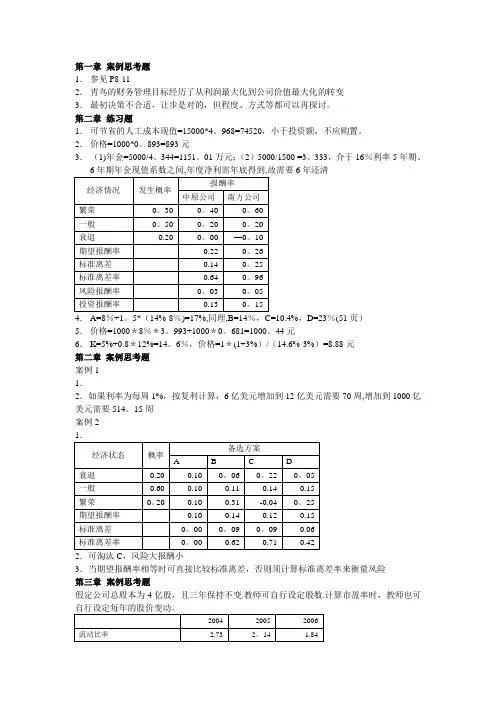
第一章案例思考题1.参见P8-112.青鸟的财务管理目标经历了从利润最大化到公司价值最大化的转变3.最初决策不合适,让步是对的,但程度、方式等都可以再探讨。
第二章练习题1.可节省的人工成本现值=15000*4。
968=74520,小于投资额,不应购置。
2.价格=1000*0。
893=893元3.(1)年金=5000/4。
344=1151。
01万元;(2)5000/1500 =3。
333,介于16%利率5年期、6年还清4.A=8%+1。
5*(14%-8%)=17%,同理,B=14%,C=10.4%,D=23%(51页)5.价格=1000*8%*3。
993+1000*0。
681=1000。
44元6.K=5%+0.8*12%=14。
6%,价格=1*(1+3%)/(14.6%-3%)=8.88元第二章案例思考题案例11.2.如果利率为每周1%,按复利计算,6亿美元增加到12亿美元需要70周,增加到1000亿美元需要514。
15周案例23.当期望报酬率相等时可直接比较标准离差,否则须计算标准离差率来衡量风险第三章案例思考题假定公司总股本为4亿股,且三年保持不变.教师可自行设定股数.计算市盈率时,教师也可第四章练习题1. 解:每年折旧=(140+100)÷4=60(万元)每年营业现金流量=销售收入⨯(1-税率)-付现成本⨯(1-税率)+折旧⨯税率=220⨯(1-40%)-110⨯(1-40%)+60⨯40%=132-66+24=90(万元)(1)净现值=40⨯PVIF10%,6+90⨯PVIFA10%,4⨯PVIF10%,2-40⨯ PVIF10%,2-100⨯ PVIF10%,1-140=40⨯0.564+90⨯3.170⨯0.826-40⨯0.826-100⨯0.909-140=22。
56+235。
66-33。
04-90.9-140=—5。
72(万元)(2)获利指数=(22。
56+235.66-33.04)/(90.9+140)=0.98(3)贴现率为10%时,净现值=—5.72(万元)贴现率为9%时,净现值=40⨯PVIF9%,6+90⨯PVIFA9%,4⨯PVIF9%,2-40⨯ PVIF9%,2-100⨯PVIF9%,1-140=40⨯0。
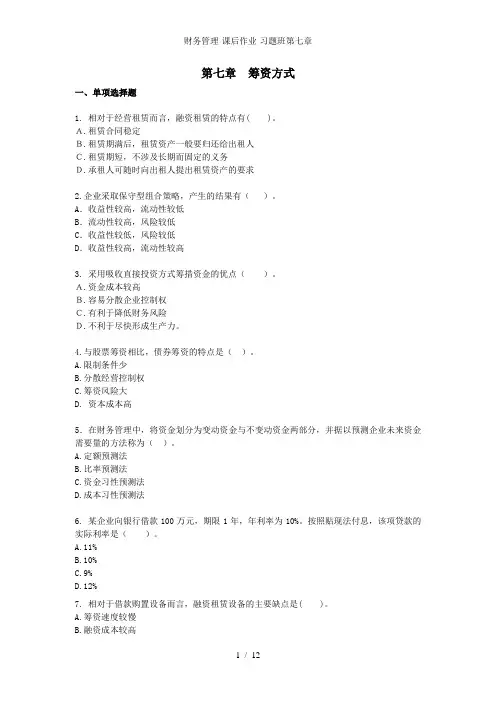
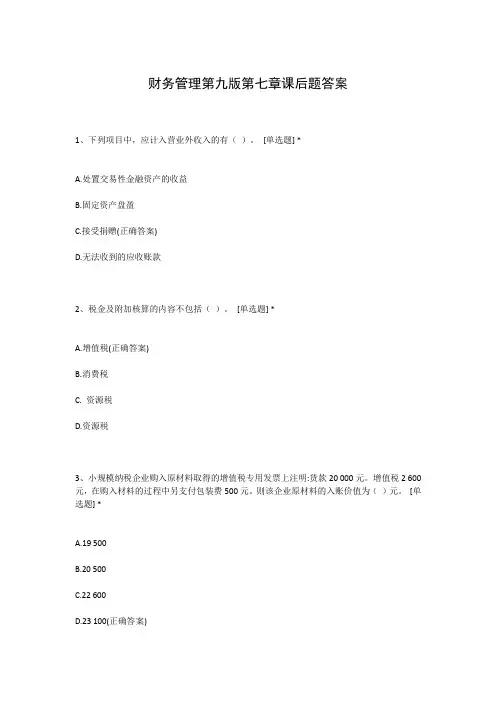
财务管理第九版第七章课后题答案1、下列项目中,应计入营业外收入的有()。
[单选题] *A.处置交易性金融资产的收益B.固定资产盘盈C.接受捐赠(正确答案)D.无法收到的应收账款2、税金及附加核算的内容不包括()。
[单选题] *A.增值税(正确答案)B.消费税C. 资源税D.资源税3、小规模纳税企业购入原材料取得的增值税专用发票上注明:货款20 000元。
增值税2 600元,在购入材料的过程中另支付包装费500元。
则该企业原材料的入账价值为()元。
[单选题] *A.19 500B.20 500C.22 600D.23 100(正确答案)4、用盈余公积弥补亏损时,应借记“盈余公积”,贷记()。
[单选题] *A.“利润分配——未分配利润”B.“利润分配——提取盈余公积”C.“本年利润”D.“利润分配——盈余公积补亏”(正确答案)5、固定资产报废清理后发生的净损失,应计入()。
[单选题] *A.投资收益B.管理费用C.营业外支出(正确答案)D.其他业务成本6、.(年浙江省第三次联考)下列项目中不需要进行会计核算的是()[单选题] *A签订销售合同(正确答案)B宣告发放现金股利C提现备发工资D结转本年亏损7、企业自创的专利权与非专利技术,其研究开发过程中发生的支出,应当区分研究阶段支出与开发阶段支出分别处理。
无法区分研究阶段支出和开发阶段支出,应当将其所发生的研发支出全部费用化,计入当期损益中的()。
[单选题] *A.管理费用(正确答案)B.财务费用C.营业外支出D.销售费用8、A企业2014年12月购入一项固定资产,原价为600万元,采用年限平均法计提折旧,使用寿命为10年,预计净残值为零,2018年1月该企业对该项固定资产的某一主要部件进行更换,发生支出合计400万元,符合固定资产确认条件,被更换的部件的原价为300万元。
则对该项固定资产进行更换后的原价为( )万元。
[单选题] *A.210B.1 000C.820D.610(正确答案)9、.(年浙江省第三次联考)下列属于事前核算职能的是()[单选题] *A记账B分析C考核D预测(正确答案)10、企业对应付的商业承兑汇票,如果到期不能足额付款,在会计处理上应将其转作()。
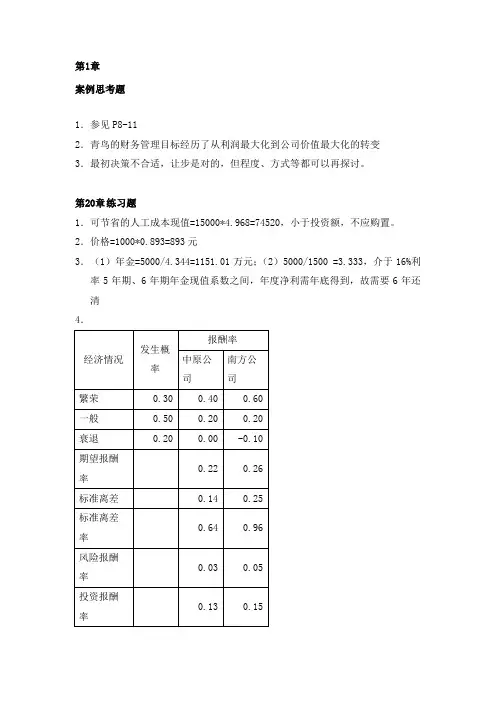
第1章案例思考题1.参见P8-112.青鸟的财务管理目标经历了从利润最大化到公司价值最大化的转变3.最初决策不合适,让步是对的,但程度、方式等都可以再探讨。
第20章练习题1.可节省的人工成本现值=15000*4.968=74520,小于投资额,不应购置。
2.价格=1000*0.893=893元3.(1)年金=5000/4.344=1151.01万元;(2)5000/1500 =3.333,介于16%利率5年期、6年期年金现值系数之间,年度净利需年底得到,故需要6年还清4.5.A=8%+1.5*14%=29%,同理,B=22%,C=13.6%,D=43%6.价格=1000*8%*3.993+1000*0.681=1000.44元7.K=5%+0.8*12%=14.6%,价格=1*(1+3%)/(14.6%-3%)=8.88元第二章案例思考题案例11.365721761+1%1+8.54% 1267.182⨯⨯⨯=()()亿元2.如果利率为每周1%,按复利计算,6亿美元增加到12亿美元需要70周,增加到1000亿美元需要514.15周案例21.2.可淘汰C,风险大报酬小3.当期望报酬率相等时可直接比较标准离差,否则须计算标准离差率来衡量风险第21章案例思考题假定公司总股本为4亿股,且三年保持不变。
教师可自行设定股数。
计算市盈率时,教师也可自行设定每年的股价变动。
趋势分析可做图,综合分析可用杜邦体系。
第四章 练习题1.解:每年折旧=(140+100)4=60(万元)每年营业现金流量=销售收入(1税率)付现成本(1税率)+折旧税率=220(140%)110(140%)+6040%=13266+24=90(万元)投资项目的现金流量为:140 1004010%,610%,410%,210%,2100PVIF 10%,1140=400.564+903.1700.826400.8261000.909140=22.56+235.6633.0490.9140=-5.72(万元)(2)获利指数=(22.56+235.6633.04)/(90.9+140)=0.98(3)贴现率为10%时,净现值=-5.72(万元) 贴现率为9%时,净现值=40PVIF 9%,6+90PVIFA 9%,4PVIF 9%,240PVIF 9%,2100PVIF 9%,1140=400.596+903.2400.842400.8421000.917140=23.84+245.5333.6891.7140=-3.99(万元)设内部报酬率为r ,则:72.599.3%9%1099.3%9+-=-rr=9.41%综上,由于净现值小于0,获利指数小于1,贴现率小于资金成本10%,故项目不可行。
CHAPTER 7 FUTURES AND OPTIONS ON FOREIGN EXCHANGESUGGESTED ANSWERS AND SOLUTIONS TO END-OF-CHAPTERQUESTIONS AND PROBLEMSQUESTIONS1. Explain the basic differences between the operation of a currency forward market and a futures market.Answer: The forward market is an OTC market where the forward contract for purchase or sale of foreign currency is tailor-made between the client and its international bank. No money changes hands until the maturity date of the contract when delivery and receipt are typically made. A futures contract is an exchange-traded instrument with standardized features specifying contract size and delivery date. Futures contracts are marked-to-market daily to reflect changes in the settlement price. Delivery is seldom made in a futures market. Rather a reversing trade is made to close out a long or short position.2. In order for a derivatives market to function most efficiently, two types of economic agents are needed: hedgers and speculators. Explain.Answer: Two types of market participants are necessary for the efficient operation of a derivatives market: speculators and hedgers. A speculator attempts to profit from a change in the futures price. To do this, the speculator will take a long or short position in a futures contract depending upon his expectations of future price movement. A hedger, on-the-other-hand, desires to avoid price variation by locking in a purchase price of the underlying asset through a long position in a futures contract or a sales price through a short position. In effect, the hedger passes off the risk of price variation to the speculator who is better able, or at least more willing, to bear this risk.3. Why are most futures positions closed out through a reversing trade rather than held to delivery?Answer: In forward markets, approximately 90 percent of all contracts that are initially established result in the short making delivery to the long of the asset underlying the contract. This is natural because the terms of forward contracts are tailor-made between the long and short. By contrast, only about one percent of currency futures contracts result in delivery. While futures contracts are useful for speculation and hedging, their standardized delivery dates make them unlikely to correspond to the actual future dates when foreign exchange transactions will occur. Thus, they are generally closed out in a reversing trade. In fact, the commission thatbuyers and sellers pay to transact in the futures market is a single amount that covers the round-trip transactions of initiating and closing out the position.4. How can the FX futures market be used for price discovery?Answer: To the extent that FX forward prices are an unbiased predictor of future spot exchange rates, the market anticipates whether one currency will appreciate or depreciate versus another. Because FX futures contracts trade in an expiration cycle, different contracts expire at different periodic dates into the future. The pattern of the prices of these cont racts provides information as to the market’s current belief about the relative future value of one currency versus another at the scheduled expiration dates of the contracts. One will generally see a steadily appreciating or depreciating pattern; however, it may be mixed at times. Thus, the futures market is useful for price discovery, i.e., obtaining the market’s forecast of the spot exchange rate at different future dates.5. What is the major difference in the obligation of one with a long position in a futures (or forward) contract in comparison to an options contract?Answer: A futures (or forward) contract is a vehicle for buying or selling a stated amount of foreign exchange at a stated price per unit at a specified time in the future. If the long holds the contract to the delivery date, he pays the effective contractual futures (or forward) price, regardless of whether it is an advantageous price in comparison to the spot price at the delivery date. By contrast, an option is a contract giving the long the right to buy or sell a given quantity of an asset at a specified price at some time in the future, but not enforcing any obligation on him if the spot price is more favorable than the exercise price. Because the option owner does not have to exercise the option if it is to his disadvantage, the option has a price, or premium, whereas no price is paid at inception to enter into a futures (or forward) contract.6. What is meant by the terminology that an option is in-, at-, or out-of-the-money?Answer: A call (put) option with S t > E (E > S t) is referred to as trading in-the-money. If S t E the option is trading at-the-money. If S t< E (E < S t) the call (put) option is trading out-of-the-money.7. List the arguments (variables) of which an FX call or put option model price is a function. How does the call and put premium change with respect to a change in the arguments?Answer: Both call and put options are functions of only six variables: S t, E, r i, r$, T andσ. When all else remains the same, the price of a European FX call (put) option will increase:1. the larger (smaller) is S,2. the smaller (larger) is E,3. the smaller (larger) is r i,4. the larger (smaller) is r$,5. the larger (smaller) r$ is relative to r i, and6. the greater is σ.When r$ and r i are not too much different in size, a European FX call and put will increase in price when the option term-to-maturity increases. However, when r$ is very much larger than r i, a European FX call will increase in price, but the put premium will decrease, when the option term-to-maturity increases. The opposite is true when r i is very much greater than r$. For American FX options the analysis is less complicated. Since a longer term American option can be exercised on any date that a shorter term option can be exercised, or a some later date, it follows that the all else remaining the same, the longer term American option will sell at a price at least as large as the shorter term option.PROBLEMS1. Assume today’s settlement price on a CME EUR futures contract is $1.3140/EUR. You have a short position in one contract. Your performance bond account currently has a balance of $1,700. The next three day s’ settlement prices are $1.3126, $1.3133, and $1.3049. Calculate the changes in the performance bond account from daily marking-to-market and the balance of the performance bond account after the third day.Solution: $1,700 + [($1.3140 - $1.3126) + ($1.3126 - $1.3133)+ ($1.3133 - $1.3049)] x EUR125,000 = $2,837.50,where EUR125,000 is the contractual size of one EUR contract.2. Do problem 1 again assuming you have a long position in the futures contract.Solution: $1,700 + [($1.3126 - $1.3140) + ($1.3133 - $1.3126) + ($1.3049 - $1.3133)] x EUR125,000 = $562.50,where EUR125,000 is the contractual size of one EUR contract.With only $562.50 in your performance bond account, you would experience a margin call requesting that additional funds be added to your performance bond account to bring the balance back up to the initial performance bond level.3. Using the quotations in Exhibit 7.3, calculate the face value of the open interest in the June 2005 Swiss franc futures contract.Solution: 2,101 contracts x SF125,000 = SF262,625,000.where SF125,000 is the contractual size of one SF contract.4. Using the quotations in Exhibit 7.3, note that the June 2005 Mexican peso futures contract has a price of $0.08845. You believe the spot price in June will be $0.09500. What speculative position would you enter into to attempt to profit from your beliefs? Calculate your anticipated profits, assuming you take a position in three contracts. What is the size of your profit (loss) if the futures price is indeed an unbiased predictor of the future spot price and this price materializes?Solution: If you expect the Mexican peso to rise from $0.08845 to $0.09500, you would take a long position in futures since the futures price of $0.08845 is less than your expected spot price.Your anticipated profit from a long position in three contracts is: 3 x ($0.09500 - $0.08845) x MP500,000 = $9,825.00, where MP500,000 is the contractual size of one MP contract.If the futures price is an unbiased predictor of the expected spot price, the expected spot price is the futures price of $0.08845/MP. If this spot price materializes, you will not have any profits or losses from your short position in three futures contracts: 3 x ($0.08845 - $0.08845) x MP500,000 = 0.5. Do problem 4 again assuming you believe the June 2005 spot price will be $0.08500.Solution: If you expect the Mexican peso to depreciate from $0.08845 to $0.07500, you would take a short position in futures since the futures price of $0.08845 is greater than your expected spot price.Your anticipated profit from a short position in three contracts is: 3 x ($0.08845 - $0.07500) x MP500,000 = $20,175.00.If the futures price is an unbiased predictor of the future spot price and this price materializes, you will not profit or lose from your long futures position.6. George Johnson is considering a possible six-month $100 million LIBOR-based, floating-rate bank loan to fund a project at terms shown in the table below. Johnson fears a possible rise in the LIBOR rate by December and wants to use the December Eurodollar futures contract to hedge this risk. The contract expires December 20, 1999, has a US$ 1 million contract size, and a discount yield of7.3 percent.Johnson will ignore the cash flow implications of marking to market, initial margin requirements, and any timing mismatch between exchange-traded futures contract cash flows and the interest payments due in March.Loan TermsSeptember 20, 1999 December 20, 1999 March 20, 2000 • Borrow $100 million at • Pay interest for first three • Pay back principal September 20 LIBOR + 200 months plus interestbasis points (bps) • Roll loan over at• September 20 LIBOR = 7% December 20 LIBOR +200 bpsLoan First loan payment (9%) Second paymentinitiated and futures contract expires and principal↓↓↓•••9/20/99 12/20/99 3/20/00a. Formulate Johnson’s September 20 floating-to-fixed-rate strategy using the Eurodollar future contracts discussed in the text above. Show that this strategy would result in a fixed-rate loan, assuming an increase in the LIBOR rate to 7.8 percent by December 20, which remains at 7.8 percent through March 20. Show all calculations.Johnson is considering a 12-month loan as an alternative. This approach will result in two additional uncertain cash flows, as follows:Loan First Second Third Fourth payment initiated payment (9%) payment payment and principal ↓↓↓↓↓•••••9/20/99 12/20/99 3/20/00 6/20/00 9/20/00 b. Describe the strip hedge that Johnson could use and explain how it hedges the 12-month loan (specify number of contracts). No calculations are needed.CFA Guideline Answera. The basis point value (BPV) of a Eurodollar futures contract can be found by substituting the contract specifications into the following money market relationship:BPV FUT = Change in Value = (face value) x (days to maturity / 360) x (change in yield)= ($1 million) x (90 / 360) x (.0001)= $25The number of contract, N, can be found by:N = (BPV spot) / (BPV futures)= ($2,500) / ($25)= 100ORN = (value of spot position) / (face value of each futures contract)= ($100 million) / ($1 million)= 100ORN = (value of spot position) / (value of futures position)= ($100,000,000) / ($981,750)where value of futures position = $1,000,000 x [1 – (0.073 / 4)]102 contractsTherefore on September 20, Johnson would sell 100 (or 102) December Eurodollar futures contracts at the 7.3 percent yield. The implied LIBOR rate in December is 7.3 percent as indicated by the December Eurofutures discount yield of 7.3 percent. Thus a borrowing rate of 9.3 percent (7.3 percent + 200 basis points) can be locked in if the hedge is correctly implemented.A rise in the rate to 7.8 percent represents a 50 basis point (bp) increase over the implied LIBOR rate. For a 50 basis point increase in LIBOR, the cash flow on the short futures position is:= ($25 per basis point per contract) x 50 bp x 100 contracts= $125,000.However, the cash flow on the floating rate liability is:= -0.098 x ($100,000,000 / 4)= - $2,450,000.Combining the cash flow from the hedge with the cash flow from the loan results in a net outflow of $2,325,000, which translates into an annual rate of 9.3 percent:= ($2,325,000 x 4) / $100,000,000 = 0.093This is precisely the implied borrowing rate that Johnson locked in on September 20. Regardless of the LIBOR rate on December 20, the net cash outflow will be $2,325,000, which translates into an annualized rate of 9.3 percent. Consequently, the floating rate liability has been converted to a fixed rate liability in the sense that the interest rate uncertainty associated with the March 20 payment (using the December 20 contract) has been removed as of September 20.b. In a strip hedge, Johnson would sell 100 December futures (for the March payment), 100 March futures (for the June payment), and 100 June futures (for the September payment). The objective is to hedge each interest rate payment separately using the appropriate number of contracts. The problem is the same as in Part A except here three cash flows are subject to rising rates and a strip of futures is used to hedge this interest rate risk. This problem is simplified somewhat because the cash flow mismatch between thefutures and the loan payment is ignored. Therefore, in order to hedge each cash flow, Johnson simply sells 100 contracts for each payment. The strip hedge transforms the floating rate loan into a strip of fixed rate payments. As was done in Part A, the fixed rates are found by adding 200 basis points to the implied forward LIBOR rate indicated by the discount yield of the three different Eurodollar futures contracts. The fixed payments will be equal when the LIBOR term structure is flat for the first year.7. Jacob Bower has a liability that:• has a principal balance of $100 million on June 30, 1998,• accrues interest quarterly starting on June 30, 1998,• pays interest quarterly,• has a one-year term to maturity, and• calculates interest due based on 90-day LIBOR (the London Interbank OfferedRate).Bower wishes to hedge his remaining interest payments against changes in interest rates.Bower has correctly calculated that he needs to sell (short) 300 Eurodollar futures contracts to accomplish the hedge. He is considering the alternative hedging strategies outlined in the following table.Initial Position (6/30/98) in90-Day LIBOR Eurodollar ContractsStrategy A Strategy BContract Month (contracts) (contracts)September 1998 300 100December 1998 0 100March 1999 0 100a. Explain why strategy B is a more effective hedge than strategy A when the yield curveundergoes an instantaneous nonparallel shift.b. Discuss an interest rate scenario in which strategy A would be superior to strategy B.CFA Guideline Answera. Strategy B’s SuperiorityStrategy B is a strip hedge that is constructed by selling (shorting) 100 futures contracts maturing in each of the next three quarters. With the strip hedge in place, each quarter of the coming year is hedged against shifts in interest rates for that quarter. The reason Strategy B will be a more effective hedge than Strategy A for Jacob Bower is that Strategy B is likely to work well whether a parallel shift or a nonparallel shift occurs over the one-year term of Bower’s liability. That is, regardless of what happens to the term structure, Strategy B structures the futures hedge so that the rates reflected by the Eurodollar futures cash price match the applicable rates for the underlying liability-the 90day LIBOR-based rate on Bower’s liability. The same is not true for Strategy A. Because Jacob Bower’s liability carries a floating interest rate that resets quarterly, he needs a strategy that provides a series of three-month hedges. Strategy A will need to be restructured when the three-month September contract expires. In particular, if the yield curve twists upward (futures yields rise more for distant expirations than for near expirations), Strategy A will produce inferior hedge results.b. Scenario in Which Strategy A is SuperiorStrategy A is a stack hedge strategy that initially involves selling (shorting) 300 September contracts. Strategy A is rarely better than Strategy B as a hedging or risk-reduction strategy. Only from the perspective of favorable cash flows is Strategy A better than Strategy B. Such cash flows occur only in certain interest rate scenarios. For example Strategy A will work as well as Strategy B for Bower’s liability if interest rates (instantaneously) change in parallel fashion. Another interest rate scenario where Strategy A outperforms Strategy B is one in which the yield curve rises but with a twist so that futures yields rise more for near expirations than for distant expirations. Upon expiration of the September contract, Bower will have to roll out his hedge by selling 200 December contracts to hedge the remaining interest payments. This action will have the effect that the cash flow from Strategy A will be larger than the cash flow from Strategy B because the appreciation on the 300 short September futures contracts will be larger than the cumulative appreciation in the 300 contracts shorted in Strategy B (i.e., 100 September, 100 December, and 100 March). Consequently, the cash flow from Strategy A will more than offset the increase in the interest payment on the liability, whereas the cash flow from Strategy B will exactly offset the increase in the interest payment on the liability.8. Use the quotations in Exhibit 7.7 to calculate the intrinsic value and the time value of the 97 September Japanese yen American call and put options.Solution: Premium - Intrinsic Value = Time Value97 Sep Call 2.08 - Max[95.80 – 97.00 = - 1.20, 0] = 2.08 cents per 100 yen97 Sep Put 2.47 - Max[97.00 – 95.80 = 1.20, 0] = 1.27 cents per 100 yen9. Assume spot Swiss franc is $0.7000 and the six-month forward rate is $0.6950. What is the minimum price that a six-month American call option with a striking price of $0.6800 should sell for in a rational market? Assume the annualized six-month Eurodollar rate is 3 ½ percent.Solution:Note to Instructor: A complete solution to this problem relies on the boundary expressions presented in footnote 3 of the text of Chapter 7.C a≥Max[(70 - 68), (69.50 - 68)/(1.0175), 0]≥Max[ 2, 1.47, 0] = 2 cents10. Do problem 9 again assuming an American put option instead of a call option.Solution: P a≥Max[(68 - 70), (68 - 69.50)/(1.0175), 0]≥Max[ -2, -1.47, 0] = 0 cents11. Use the European option-pricing models developed in the chapter to value the call of problem 9 and the put of problem 10. Assume the annualized volatility of the Swiss franc is 14.2 percent. This problem can be solved using the FXOPM.xls spreadsheet.Solution:d1 = [ln(69.50/68) + .5(.142)2(.50)]/(.142)√.50 = .2675d2 = d1 - .142√.50 = .2765 - .1004 = .1671N(d1) = .6055N(d2) = .5664N(-d1) = .3945N(-d2) = .4336C e = [69.50(.6055) - 68(.5664)]e-(.035)(.50) = 3.51 centsP e = [68(.4336) - 69.50(.3945)]e-(.035)(.50) = 2.03 cents12. Use the binomial option-pricing model developed in the chapter to value the call of problem 9.The volatility of the Swiss franc is 14.2 percent.Solution: The spot rate at T will be either 77.39¢ = 70.00¢(1.1056) or 63.32¢ = 70.00¢(.9045), where u = e.142 .50 = 1.1056 and d = 1/u = .9045. At the exercise price of E = 68, the option will only be exercised at time T if the Swiss franc appreciates; its exercise value would be C uT= 9.39¢ = 77.39¢ - 68. If the Swiss franc depreciates it would not be rational to exercise the option; its value would be C dT = 0.The hedge ratio is h = (9.39 – 0)/(77.39 – 63.32) = .6674.Thus, the call premium is:C0 = Max{[69.50(.6674) – 68((70/68)(.6674 – 1) +1)]/(1.0175), 70 – 68}= Max[1.64, 2] = 2 cents per SF.MINI CASE: THE OPTIONS SPECULATORA speculator is considering the purchase of five three-month Japanese yen call options with a striking price of 96 cents per 100 yen. The premium is 1.35 cents per 100 yen. The spot price is 95.28 cents per 100 yen and the 90-day forward rate is 95.71 cents. The speculator believes the yen will appreciate to $1.00 per 100 yen over the next three months. As the speculator’s assistant, you have been asked to prepare the following:1. Graph the call option cash flow schedule.2. Determine the speculator’s profit if the yen appreciates to $1.00/100 yen.3. Determine the speculator’s profit if the yen only appreciates to the forward rate.4. Determine the future spot price at which the speculator will only break even.Suggested Solution to the Options Speculator:1.-2. (5 x ¥6,250,000) x [(100 - 96) - 1.35]/10000 = $8,281.25.3. Since the option expires out-of-the-money, the speculator will let the option expire worthless. He will only lose the option premium.4. S T = E + C = 96 + 1.35 = 97.35 cents per 100 yen.。
思考题1.答题要点:如果通过事后审计将赔偿责任引入投资项目的预测阶段,从积极的方面来说,由于赔偿责任的约束,一方面进行投资预测的工作人员会不断地改进预测方法,总结经验教训,更加认真踏实地做好本职工作,从而提高投资项目预测的准确度,从而持续提高投资管理的效率。
另一方面,进行投资预测的工作人员在进行项目预测时会更加谨慎,从而降低企业的投资风险。
从消极的方面来说,由于赔偿责任的存在,进行预测的工作人员为了规避这种风险,可能故意低估一些风险比较大的项目的决策指标,从而使公司丧失投资效率最高的项目。
另外,某一项目的实际值和预测值的偏差可能是多种原因导致的,其中可能有环境变化方面的原因,可能有投资实施阶段的原因,如果责任划分不清,会使投资项目预测的工作人员感到不公平,降低他们的工作满意度,从而影响他们的工作积极性,主动性和创造性,最终对投资项目造成不利影响。
2.答题要点:按照现金流量的发生时间,投资活动的现金流量可以被分为初始现金流量、营业现金流量和终结现金流量。
初始现金流量一般包括如下的几个部分:(1)投资前费用;(2)设备购置费用;(3)设备安装费用;(4)建筑工程费;(5)营运资金的垫支;(6)原有固定资产的变价收入扣除相关税金后的净收益;(7)不可预见费。
营业现金流量一般以年为单位进行计算。
营业现金流入一般是指营业现金收入,营业现金流出是指营业现金支出和交纳的税金。
终结现金流量主要包括:(1)固定资产的残值收入或变价收入(指扣除了所需要上缴的税金等支出后的净收入);(2)原有垫支在各种流动资产上的资金的收回;(3)停止使用的土地的变价收入等。
投资决策采用折现现金流量指标更合理的的原因是:(1)非折现指标把不同时间点上的现金收入和支出当作毫无差别的资金进行对比,忽略了资金的时间价值因素,这是不科学的。
而折现指标则把不同时间点收入或支出的现金按照统一的折现率折算到同一时间点上,使不同时期的现金具有可比性,这样才能做出正确的投资决策。
ChProblems1. City Farm Insurance has collection centers across the country to speed up collections. Thecompany also makes its disbursements from remote disbursement centers. The collection time has been reduced by two days and disbursement time increased by one day because of these policies. Excess funds are being invested in short-term instruments yielding12 percent per annum.a. If City Farm has $5 million per day in collections and $3 million per day indisbursements, how many dollars has the cash management system freed up?b. How much can City Farm earn in dollars per year on short-term investments madepossible by the freed-up cash?7-1. Solution:City Farm Insurancea. $5,000,000 daily collections× 2.0 days speed up = $10,000,000 additional collections$3,000,000 daily disbursements× 1.0 days slow down = $ 3,000,000 delayed disbursements$13,000,000 freed-up fundsb. $13,000,000 freed-up funds12% interest rate$1,560,000 interest on freed-up cash2. Nicholas Birdcage Company of Hollywood ships cages throughout the country. Nicholashas determined that through the establishment of local collection centers around thecountry, he can speed up the collection of payments by one and one-half days. Furthermore, the cash management department of his bank has indicated to him that he can defer hispayments on his accounts by one-half day without affecting suppliers. The bank has aremote disbursement center in Florida.a. If the company has $4 million per day in collections and $2 million per day indisbursements, how many dollars will the cash management system free up?b. If the company can earn 9 percent per annum on freed-up funds, how much will theincome be?c. If the annual cost of the new system is $700,000, should it be implemented?7-2. Solution:Nicholas Birdcage Company of Hollywooda. $4,000,000 daily collections× 1.5 days speed up = $6,000,000 additional collections$2,000,000 daily disbursements× .5 days slow down = $1,000,000 delayed disbursements$7,000,000 freed-up fundsb. $7,000,000 freed-up funds9% interest rate$630,000 interest on freed-up cashc. No. The annual income of $630,000 is $70,000 less than theannual cost of $700,000 for the new system.3. Megahurtz International Car Rentals has rent-a-car outlets throughout the world. It alsokeeps funds for transactions purposes in many foreign countries. Assume in 2003, it held 100,000 reals in Brazil worth 35,000 dollars. It drew 12 percent interest, but the Brazilian real declined 20 percent against the dollar.a. What is the value of its holdings, based on U.S. dollars, at year-end (Hint: multiply$35,000 times 1.12 and then multiply the resulting value by 80 percent.)b. What is the value of its holdings, based on U.S. dollars, at year-end if it drew9 percent interest and the real went up by 10 percent against the dollar?7-3. Solution:Megahurtz International Car Rentala. $35,000 × 1.12 = $39,200$39,200 × 80% = $31,360 dollar value of real holdingsb. $35,000 × 1.09 = $38,150$38,150 × 110% = $41,965 dollar value of real holdings4. Thompson Wood Products has credit sales of $2,160,000 and accounts receivableof $288,000. Compute the value of the average collection period.7-4. Solution:Thompson Wood ProductsAccounts Receivable Average collection period Average daily credit sales$288,000$2,160,000/360$288,00048days $6,000====5. Lone Star Petroleum Co. has annual credit sales of $2,880,000 and accounts receivableof $272,000. Compute the value of the average collection period.7-5. Solution:Lone Star Petroleum Co.Accounts Receivable Average collection period Average daily credit sales$272,000$2,288,000/360$272,0008,00034days ====6. Knight Roundtable Co. has annual credit sales of $1,080,000 and an average collectionperiod of 32 days in 2008. Assume a 360-day year. What is the company ’s averageaccounts receivable balance? Accounts receivable are equal to the average daily credit sales times the average collection period.7-6. Solution:Knight Roundtable Co.$1,080,000annual credit sales $3,000credit sales a day 360days per year=$3,000 average 32 average $96,000 average accounts daily credit sales collection period receivable balance=⨯7.Darla ’s Cosmetics has annual credit sales of $1,440,000 and an average collection period of 45 days in 2008. Assume a 360-day year.What is the company ’s average accounts receivable balance? Accounts receivable are equal to the average daily credit sales times the average collection period. 7-7. Solution:Darla ’s Cosmetic Company$1,440,000 annual credit sales/360 = $4,000 per day credit sales $4,000 credit sales × 45 average collection period = $180,000average accounts receivable balance8. In Problem 7, if accounts receivable change to $200,000 in the year 2009, while credit salesare $1,800,000, should we assume the firm has a more or a less lenient credit policy? 7-8. Solution:Darla ’s Cosmetics (Continued)To determine if there is a more lenient credit policy, compute the average collection period.Accounts ReceivableAverage collection period Average daily credit sales$200,000$1,800,000/360$200,00040 days $5,000====Since the firm has a shorter average collection period, it appears that the firm does not have a more lenient credit policy.9. Hubbell Electronic Wiring Company has an average collection period of 35 days. Theaccounts receivable balance is $105,000. What is the value of its credit sales?7-9. Solution:Hubbell Electronic Wiring CompanyAccounts receivable Average collection period Average daily credit sales$105,00035 days credit sales 360$105,000Credit sales/36035 daysCredit sales/360$3,000 credit sales per dayCredit sales $3,==⎛⎫ ⎪⎝⎭===000360$1,080,000⨯=10. Marv ’s Women ’s Wear has the following schedule for aging of accounts receivable.Age of Receivables, April 30, 2004(1)(2) (3) (4)Month of SalesAge of Account Amounts Percent of Amount Due April .................................0–30 $ 88,000 ____ March ...............................31–60 44,000 ____ February ...........................61–90 33,000 ____ January .............................91–120 55,000 ____ Total receivables ...........$220,000 100%a . Fill in column (4) for each month.b . If the firm had $960,000 in credit sales over the four-month period, compute the average collection period. Average daily sales should be based on a 120-day period.c . If the firm likes to see its bills collected in 30 days, should it be satisfied with the average collection period?d . Disregarding your answer to part c and considering the aging schedule for accounts receivable, should the company be satisfied? e . What additional information does the aging schedule bring to the company that theaverage collection period may not show?7-10. Solution:Marv’s Women’s WearAge of Receivables, April 30, 2004a.(1)(2)(3)(4)Month of SalesAge ofAccount AmountsPercent ofAmount DueApril 0-30 $ 88,000 40% March 31-60 44,000 20% February 61-90 33,000 15% January 91-120 55,000 25% Total receivables $220,000 100%b.Accounts receivable Average Collection PeriodAverage daily credit sales$220,000$960,000/120$220,000$8,00027.5 days====c. Yes, the average collection of 27.5 days is less than 30 days.d. No. The aging schedule provides additional insight that 60percent of the accounts receivable are over 30 days old.e. It goes beyond showing how many days of credit salesaccounts receivables represent, to indicate the distribution of accounts receivable between various time frames.11. Nowlin Pipe & Steel has projected sales of 72,000 pipes this year, an ordering cost of$6 per order, and carrying costs of $2.40 per pipe.a . What is the economic ordering quantity?b . How many orders will be placed during the year?c . What will the average inventory be?7-11. Solution:Nowlin Pipe and Steel Companya. EOQ 600 units =====b. 72,000 units/600 units = 120 ordersc. EOQ/2 = 600/2 = 300 units (average inventory)12. Howe Corporation is trying to improve its inventory control system and has installed anonline computer at its retail stores. Howe anticipates sales of 126,000 units per year, an ordering cost of $4 per order, and carrying costs of $1.008 per unit.a . What is the economic ordering quantity?b . How many orders will be placed during the year?c . What will the average inventory be?d . What is the total cost of inventory expected to be?7-12. Solution:Howe Corp.a. EOQ 1,000 units ===b. 126,000 units/1,000 units = 126 orders7-12. (Continued)c. EOQ/2 = 1,000/2 = 500 units (average inventory)d. 126 orders × $4 ordering cost= $ 504 500 units × $1.008 carrying cost per unit = 504 Total costs = $1,00813. (See Problem 12 for basic data.) In the second year, Howe Corporation finds it can reduceordering costs to $1 per order but that carrying costs will stay the same at $1.008 per unit. a . Recompute a, b, c , and d in Problem 12 for the second year.b . Now compare years one and two and explain what happened.7-13. Solution:Howe Corp. (Continued)a. EOQ 500 units =====126,000 units/500 units = 252 ordersEOQ/2 = 500/2 = 250 units (average inventory)252 orders × $1 ordering cost= $252 250 units × $1.008 carrying cost per unit = 252 Total costs = $504b. The number of units ordered declines 50%, while the numberof orders doubles. The average inventory and total costs both decline by one-half. Notice that the total cost did not decline in equal percentage to the decline in ordering costs. This isbecause the change in EOQ and other variables (½) isproportional to the square root of the change in orderingcosts (¼).14. Higgins Athletic Wear has expected sales of 22,500 units a year, carrying costs of $1.50per unit, and an ordering cost of $3 per order.a. What is the economic order quantity?b. What will be the average inventory? The total carrying cost?c. Assume an additional 30 units of inventory will be required as safety stock. What willthe new average inventory be? What will the new total carrying cost be?7-14. Solution:Higgins Athletic Weara. EOQ==300 units===b. EOQ/2 = 300/2 = 150 units (average inventory)150 units × $1.50 carrying cost/unit = $225 total carrying costc.EOQAverage inventory Safety Stock230030150301802=+=+=+= 180 inventory × $1.50 carrying cost per year = $270 total carrying cost15. Dimaggio Sports Equipment, Inc., is considering a switch to level production. Costefficiencies would occur under level production, and aftertax costs would decline by$35,000, but inventory would increase by $400,000. Dimaggio would have to finance the extra inventory at a cost of 10.5 percent.a. Should the company go ahead and switch to level production?b. How low would interest rates need to fall before level production would be feasible? 7-15. Solution:Dimaggio Sports Equipment, Inc.a. Inventory increases by $400,000× interest expense 10.5%Increased costs $ 42,000Less: Savings 35,000Loss ($ 7,000)Don’t switch to level production. Increased ROI is less thanthe interest cost of more inventory.b. If interest rates fall to 8.75% or less, the switch would befeasible.$35,000 Savings8.75%$400,000 increased inventory16. Johnson Electronics is considering extending trade credit to some customers previouslyconsidered poor risks. Sales will increase by $100,000 if credit is extended to these new customers. Of the new accounts receivable generated, 10 percent will prove to beuncollectible. Additional collection costs will be 3 percent of sales, and production and selling costs will be 79 percent of sales. The firm is in the 40 percent tax bracket.a. Compute the incremental income after taxes.b. What will Johnson’s incremental return on sales be if these new credit customers areaccepted?c. If the receivable turnover ratio is 6 to 1, and no other asset buildup is needed to servethe new customers, what will Johnson’s incremental return on new averageinvestment be?7-16. Solution:Johnson Electronicsa. Additional sales .................................................... $100,000Accounts uncollectible (10% of new sales) ......... – 10,000Annual incremental revenue ................................ $ 90,000Collection costs (3% of new sales) ...................... – 3,000Production and selling costs (79% of new sales) .– 79,000Annual income before taxes ................................. $ 8,000Taxes (40%) ......................................................... – 3,200Incremental income after taxes ............................ $ 4,800b.Incremental income Incremental return on salesIncremental sales$4,800/$100,000 4.8%===c. Receivable turnover = Sales/Receivable turnover = 6xReceivables = Sales/Receivable turnover= $100,000/6= $16,666.67Incremental return on new average investment =$4,800/$16,666.67 = 28.80%17. Collins Office Supplies is considering a more liberal credit policy to increase sales, butexpects that 9 percent of the new accounts will be uncollectible. Collection costs are5 percent of new sales, production and selling costs are 78 percent, and accounts receivableturnover is five times. Assume income taxes of 30 percent and an increase in sales of$80,000. No other asset buildup will be required to service the new accounts.a. What is the level of accounts receivable to support this sales expansion?b. What would be Collins’s incremental aftertax return on investment?c. Should Collins liberalize credit if a 15 percent aftertax return on investment isrequired?Assume Collins also needs to increase its level of inventory to support new sales and that inventory turnover is four times.d. What would be the total incremental investment in accounts receivable and inventoryto support a $80,000 increase in sales?e. Given the income determined in part b and the investment determined in part d,should Collins extend more liberal credit terms?7-17. Solution:Collins Office Suppliesa.$80,000 Investment in accounts receivable$16,0005==b. Added sales .......................................................... $ 80,000Accounts uncollectible (9% of new sales) ........... – 7,200 Annual incremental revenue ................................ $ 72,800 Collection costs (5% of new sales) ...................... – 4,000 Production and selling costs (78% of new sales) – 62,400 Annual income before taxes ................................. $ 6,400 Taxes (30%) ......................................................... – 1,920 Incremental income after taxes ............................ $ 4,480Return on incremental investment = $4,480/$16,000 = 28% c. Yes! 28% exceeds the required return of 15%.7-17. (Continued)d.$80,000 Investment in inventory =$20,0004Total incremental investmentInventory $20,000Accounts receivable 16,000Incremental investment $36,000 $4,480/$36,000 = 12.44% return on investmente. No! 12.44% is less than the required return of 15%.18. Curtis Toy Manufacturing Company is evaluating the extension of credit to a new group ofcustomers. Although these customers will provide $240,000 in additional credit sales,12 percent are likely to be uncollectible. The company will also incur $21,000 in additionalcollection expense. Production and marketing costs represent 72 percent of sales. Thecompany is in a 30 percent tax bracket and has a receivables turnover of six times. No other asset buildup will be required to service the new customers. The firm has a 10 percentdesired return on investment.a. Should Curtis extend credit to these customers?b. Should credit be extended if 14 percent of the new sales prove uncollectible?c. Should credit be extended if the receivables turnover drops to 1.5 and 12 percent ofthe accounts are uncollectible (as was the case in part a).Curtis Toy Manufacturing Companya. Added sales ............................................................. $240,000Accounts uncollectible (12% of new sales) ............ 28,800 Annual incremental revenue ................................... 211,200 Collection costs ....................................................... 21,000 Production and selling costs (72% of new sales) .... 172,800 Annual income before taxes .................................... 17,400 Taxes (30%) ............................................................ 5,220 Incremental income after taxes ............................... $ 12,180 $240,000Receivable turnover 6.0x 6.040,000 in new receivables ==$12,180Return on incremental investment 30.45%$40,000== b. Added sales ..........................................................$240,000 Accounts uncollectible (14% of new sales) .........– 33,600 Annual incremental revenue ................................$206,400 Collection costs ....................................................– 21,000 Production and selling costs (72% of new sales) .–172,800 Annual income before taxes .................................$ 12,600 Taxes (30%) .........................................................– 3,780 Incremental income after taxes ............................ $ 8,820$8,820Return on incremental investment 22.05%$40,000== Yes, extend credit.c. If receivable turnover drops to 1.5x, the investment inaccounts receivable would equal $240,000/1.5 = $160,000.The return on incremental investment, assuming a 12%uncollectible rate, is 7.61%.$12,180==Return on incremental investment7.61%$160,000The credit should not be extended. 7.61% is less than thedesired 10%.19. Reconsider problem 18. Assume the average collection period is 120 days. All other factorsare the same (including 12 percent uncollectibles). Should credit be extended?7-19. Solution:Curtis Toy Manufacturing Company (Continued) First compute the new accounts receivable balance.Accounts receivable = average collection period × average dailysales240,000120 days120$667$80,040⨯=⨯=360 daysorAccounts receivable = sales/accounts receivable turnover360 days==Accounts receivable turnover3x120 days=$240,000/3$80,000Then compute return on incremental investment.$12,18015.23%=$80,000Yes, extend credit. 15.23% is greater than 10%.20. Apollo Data Systems is considering a promotional campaign that will increase annualcredit sales by $600,000. The company will require investments in accounts receivable, inventory, and plant and equipment. The turnover for each is as follows:Accounts receivable (5x)Inventory (8x)Plant and equipment (2x)All $600,000 of the sales will be collectible. However, collection costs will be 3 percent of sales, and production and selling costs will be 77 percent of sales. The cost to carryinventory will be 6 percent of inventory. Depreciation expense on plant and equipment will be 7 percent of plant and equipment. The tax rate is 30 percent.a. Compute the investments in accounts receivable, inventory, and plant and equipmentbased on the turnover ratios. Add the three together.b. Compute the accounts receivable collection costs and production and selling costsand add the two figures together.c. Compute the costs of carrying inventory.d. Compute the depreciation expense on new plant and equipment.e. Add together all the costs in parts b, c, and d.f. Subtract the answer from part e from the sales figure of $600,000 to arrive at incomebefore taxes. Subtract taxes at a rate of 30 percent to arrive at income after taxes.g. Divide the aftertax return figure in part f by the total investment figure in part a. If thefirm has a required return on investment of 12 percent, should it undertake thepromotional campaign described throughout this problem.7-20. Solution:Apollo Data Systemsa. Accounts receivable = sales/accounts receivable turnover=$120,000$600,000/5Inventory = sales/inventory turnover=$75,000$600,000/8Plant and equipment = sales/(plant and equipment turnover)=$600,000/2$300,000Total investment$495,0007-20. (Continued)b. Collection cost = 3% × $600,000 $ 18,000Production and selling costs = 77% × $600,000 = 462,000Total costs related to accounts receivable $480,000c. Cost of carrying inventory6% × inventory6% × $75,000 $4,500d. Depreciation expense7% × Plant and Equipment7% × $300,000 $21,000e. Total costs related to accounts receivable $480,000Cost of carrying inventory 4,500Depreciation expense 21,000Total costs $505,500f. Sales $600,000– total costs 505,500Income before taxes 94,500Taxes (30%) 28,350Income after taxes $ 66,150g. Income after taxes$66,15013.36%Total investment495,000==Yes, it should undertake the campaignThe aftertax return of 13.36% exceeds the required rate of return of 12%21. In Problem 20, if inventory turnover had only been 4 times:a. What would be the new value for inventory investment?b. What would be the return on investment? You need to recompute the total investmentand the total costs of the campaign to work toward computing income after taxes.Should the campaign be undertaken?7-21. Solution:Apollo Data Systems (Continued)a. Inventory = sales/inventory turnover$150,000 = $600,000/4b. New Total InvestmentAccounts receivable $120,000Inventory 150,000Plant and equipment 300,000$570,000Total Cost of the CampaignCost of carrying inventory6% × $150,000 = $9,000 ($4,500 more than previously)New Income After TaxesSales $600,000– total costs 510,000 ($505,500 + 4,500)Income before taxes 90,000Taxes (30%) 27,000Income after taxes $ 63,000Income after taxes$63,000==11.05%Total investment570,000No, the campaign should not be undertakenThe aftertax return of 11.05% is less than the required rate ofreturn of 12%(Problems 22–25 are a series and should be taken in order.)22. Maddox Resources has credit sales of $180,000 yearly with credit terms of net 30 days,which is also the average collection period. Maddox does not offer a discount for early payment, so its customers take the full 30 days to pay.What is the average receivables balance? What is the receivables turnover?7-22. Solution:Maddox ResourcesSales/360 days = average daily sales$180,000/360 = $500Accounts receivable balance = $500 × 30 days = $15,000Receivable turnover =Sales$180,00012x Receivables$15,000==or360 days/30 = 12x23. If Maddox were to offer a 2 percent discount for payment in 10 days and every customertook advantage of the new terms, what would the new average receivables balance be?Use the full sales of $180,000 for your calculation of receivables.7-23. Solution:Maddox Resources (Continued)$500 × 10 days = $5,000 new receivable balance24. If Maddox reduces its bank loans, which cost 12 percent, by the cash generated from itsreduced receivables, what will be the net gain or loss to the firm?7-24. Solution:Maddox Resources (Continued)Old receivables – new receivables with discount = Funds freed by discount$15,000 – $5,000 ................................... = $10,000Savings on loan = 12% × $10,000 .......... = $ 1,200Discount on sales = 2% × $180,000 ........ = (3,600)Net change in income from discount ...... $(2,400) No! Don’t offer the discount since the income from reduced bankloans does not offset the loss on the discount.25. Assume that the new trade terms of 2/10, net 30 will increase sales by 20 percent becausethe discount makes the Maddox price competitive. If Maddox earns 16 percent on salesbefore discounts, should it offer the discount? (Consider the same variables as you did for problems 22 through 24.)7-25. Solution:Maddox Resources (Continued)New sales = $180,000 × 1.20 = $216,000 Sales per day = $216,000/360 = $600 Average receivables balance = $600 × 10 = $6,000 Savings in interest cost ($15,000 – $6,000) × 12% = 1,080 Increase profit on new sales = 16% × $36,000* = $5,760 Reduced profit because of discount = 2% × $216,000 = (4,320) Net change in income ............................................ $2,520 Yes, offer the discount because total profit increases.*New Sales $36,000 = $216,000 – $180,000COMPREHENSIVE PROBLEMBailey Distributing Company sells small appliances to hardware stores in the southern California area. Michael Bailey, the president of the company, is thinking about changing the credit policies offered by the firm to attract customers away from competitors. The current policy calls for a1/10, net 30, and the new policy would call for a 3/10, net 50. Currently 40 percent of Bailey customers are taking the discount, and it is anticipated that this number would go up to50 percent with the new discount policy. It is further anticipated that annual sales would increase from a level of $200,000 to $250,000 as a result of the change in the cash discount policy.The increased sales would also affect the inventory level. The average inventory carried by Bailey is based on a determination of an EOQ. Assume unit sales of small appliances will increase from 20,000 to 25,000 units. The ordering cost for each order is $100 and the carrying cost per unit is $1 (these values will not change with the discount). The average inventory is based on EOQ/2. Each unit in inventory has an average cost of $6.50.Cost of goods sold is equal to 65 percent of net sales; general and administrative expenses are 10 percent of net sales; and interest payments of 12 percent will be necessary only for the increase in the accounts receivable and inventory balances. Taxes will equal 25 percent of before-tax income.a. Compute the accounts receivable balance before and after the change in the cashdiscount policy. Use the net sales (Total sales – Cash discounts) to determine theaverage daily sales and the accounts receivable balances.b. Determine EOQ before and after the change in the cash discount policy. Translate thisinto average inventory (in units and dollars) before and after the change in the cashdiscount policy.c. Complete the income statement.Before Policy Change After Policy ChangeNet sales (Sales – Cash discounts)Cost of goods soldGross profitGeneral and administrativeexpenseOperating profitInterest on increase in accountsreceivable and inventory (12%)Income before taxesTaxesIncome after taxesd. Should the new cash discount policy be utilized? Briefly comment.Bailey Distributing Companya. Accounts receivable = average collection × averageperiod daily sales Before Policy ChangeAverage collection period .40 × 10 days = 4 .60 × 30 days = 18 22 days Average daily sales()()()$200,000.01.40$200,000Credit sales Discount 360360$200,000$800360$199,200360Average daily sales $553.33--=-===22 days × $553.33 = $12,173.26 accounts receivable before policy changeAfter Policy Change Average collection period .50 × 10 days = 5 .50 × 50 days = 25 30 days。
第一章财务管理导论一、单项选题1.B2. B3. A4. B5. C6. C7. A8. A9. D10. C11. A12.B13.D14. A15.D16.B17. A18. D19.A20.D二、多项选择题1. AC2. ABC3. ABCD4. AC5. ABC6. ABC7. ABC 8.ACD 9. ABC10. AB11. ABCD12. ABCD13.ACD14. ABCD15. ABC16. BD17. ABC18. ABC19. ABCD20.ABCD三、判断题1.√2.×3.×4.×5. ×6.×7.√8.×9.×10.√11.×12.×13.×14.×15.√16.×17.√18.√19.×20.√四、业务分析题实训题(一)参考答案:(1)上述第1、3、5和6直接属于财务管理问题。
(2)公司应该加强财务管理工作,具体:加强财务管理的预算工作,为企业的现金收支和资金筹资及借款的归还制定相对详细合理的计划;加强公司的资金营运管理,为存货制定合理的经济进货批量,降低存货积压及其成本;加强公司内部的纳税申报及其缴纳工作;处理好企业财务管理过程中与职工、客户、税务机关等方面的财务关系。
实训题(二)参考答案1)财务管理目标是在特定的理财环境中,通过组织财务活动,处理财务关系所要达到的目的。
财务管理目标是一切财务活动的出发点和归宿。
将企业价值最大化目标作为企业财务管理目标的首要任务就是要协调相关利益群体的关系,化解他们之间的利益冲突。
因此,吉林亚泰集团的认股权激励方案目的在于解决企业财务管理目标实现过程中股东与管理层之间利益冲突。
在其推出这一方案时,,还具有以下背景:公司本身的发展和业务处于扩张的时期,企业急需大量的专业人才;这一方案得到了政府相关部门和大股东的支持。
第二部分复习思考参考答案第一章总论1.名词解释(1)财务管理财务管理是以企业特定的财务管理目标为导向,组织财务活动、处理财务关系的价值管理活动,是企业管理的重要组成部分。
基本内容包括:筹集管理、投资管理、营运管理、分配管理。
(2)财务关系企业财务关系是指企业在组织财务活动过程中与有关各方面发生的经济利益关系。
(3)财务目标财务目标是指企业在特定的理财环境中,组织财务活动、处理财务关系所要达到的根本目的。
它是评价企业财务管理活动是否合理的标准。
(4)财务环境财务环境是企业从事财务管理活动过程中所处的特定时间和空间。
财务环境既包括企业理财所面临的政治、经济、法律和社会文化等宏观环境,以及企业自身管理体制、经营组织形式、生产经营规模、内部管理水平等微观环境。
2.单项选择题(1)A (2)B (3)C (4)D (5)B (6)D3.多项选择题(1)ABCD (2)ACD (3)ABC (4)ABCD (5)ABC (6)CD4.判断题(1)√(2)×(3)√(4)×(5)×(6)×5.填空题(1)价值管理、信息反馈、控制与调节(2)法律环境、金融环境和经济环境(3)利润最大化、股东财富最大化、企业价值最大化(4)供应、需求6.简答题(1)企业财务活动的主要内容是什么?财务活动是指资金的筹集、投放、使用、收回及分配等一系列行为。
从整体上讲,财务活动包括筹资活动、投资活动、营运活动、分配活动。
企业的财务活动贯穿于企业生产经营活动过程的始终,具体来说包括以下内容:①资金筹集活动。
是指企业为了满足投资和用资的需要,筹措和集中所需资金的行为。
筹集资金是资金运动的起点。
②投资活动。
企业取得资金后,就要将资金投入使用,以获取最大的经济效益,否则,筹资就失去了目的和效用。
③资金营运活动。
在使用资金过程中,应加速资金周转,提高资金利用效果。
④资金收入与分配活动。
企业通过对内投资和对外投资必然会取得收入。
财务管理第七章习题一、单项选择题1. 企业将资金占用在应收账款上而放弃其他方面投资可获得的收益是应收账款的( A )。
A.管理成本B.坏账成本C.资金成本D.机会成本2.经济批量是指( D )。
A.采购成本最低的采购批量B.订货成本最低的采购批量C.储存成本最低的采购批量D.存货总成本最低的采购批量3.在对存货采用ABC法进行控制时,应当重点控制的是( B )。
A.数量较大的存货B.占用资金较多的存货C.品种多的存货D.价格昂贵的存货4.信用标准常见的表示指标是( A )。
A.信用条件B.预期的坏账损失率C.现金折扣D.信用期 5.企业置存现金,主要是为了满足( D )。
A.交易性、预防性、盈利性需要B.交易性、预防性、投机性需要C.支付性、预防性、盈利性需要D.交易性、预防性、流通性需要 6.企业评价客户登记,决定给予或拒绝客户信用的依据是( A )。
A.信用标准B.收账政策C.信用条件D.信用政策7.下列各项属于应收账款机会成本的是( C )。
A.坏账损失B.收账费用C.应收账款占用资金的应计利息D.对客户信用进行调查的费用8.现金作为一种资产,它的( A )。
A.流动性强,盈利性差B.流动性强,盈利性强C.流动性差,盈利性强D.流动性差,盈利性强9.在存货ABC分类控制法中,对存货的最基本的分类标准为(A )。
A.金额标准B.品质标准C.品种数量标准D.质量成容积标准二、多项选择题1.控制现金支出的有效措施包括( ABCD )A.推迟支付应付款B.采用汇票付款C.加速收款D.合理利用“浮游量”260 2.最佳现金持有量的模式包括( ABC )A.现金周转模式B.存货模式C.成本分析模式D.因素分析模式3.企业持有现金的动机包括( ABC )A.交易动机B.预防动机C.投机动机D.满足未来偿债要求建立偿债4.下列各项中,属于信用政策的有( BCD )A.现销政策B.信用标准C.收账政策D.信用条件5.存货成本包括( ABCD )A.缺货成本B.订货成本C.储存成本D.购置成本三、判断题1.根据存货经济订货量模型,经济订货量是能使订货总成本与储存总成本相等的订货批量(×)。
思考题1.答题要点:如果通过事后审计将赔偿责任引入投资项目的预测阶段,从积极的方面来说,由于赔偿责任的约束,一方面进行投资预测的工作人员会不断地改进预测方法,总结经验教训,更加认真踏实地做好本职工作,从而提高投资项目预测的准确度,从而持续提高投资管理的效率。
另一方面,进行投资预测的工作人员在进行项目预测时会更加谨慎,从而降低企业的投资风险。
从消极的方面来说,由于赔偿责任的存在,进行预测的工作人员为了规避这种风险,可能故意低估一些风险比较大的项目的决策指标,从而使公司丧失投资效率最高的项目。
另外,某一项目的实际值和预测值的偏差可能是多种原因导致的,其中可能有环境变化方面的原因,可能有投资实施阶段的原因,如果责任划分不清,会使投资项目预测的工作人员感到不公平,降低他们的工作满意度,从而影响他们的工作积极性,主动性和创造性,最终对投资项目造成不利影响。
2.答题要点:按照现金流量的发生时间,投资活动的现金流量可以被分为初始现金流量、营业现金流量和终结现金流量。
初始现金流量一般包括如下的几个部分:(1)投资前费用;(2)设备购置费用;(3)设备安装费用;(4)建筑工程费;(5)营运资金的垫支;(6)原有固定资产的变价收入扣除相关税金后的净收益;(7)不可预见费。
营业现金流量一般以年为单位进行计算。
营业现金流入一般是指营业现金收入,营业现金流出是指营业现金支出和交纳的税金。
终结现金流量主要包括:(1)固定资产的残值收入或变价收入(指扣除了所需要上缴的税金等支出后的净收入);(2)原有垫支在各种流动资产上的资金的收回;(3)停止使用的土地的变价收入等。
投资决策采用折现现金流量指标更合理的的原因是:(1)非折现指标把不同时间点上的现金收入和支出当作毫无差别的资金进行对比,忽略了资金的时间价值因素,这是不科学的。
而折现指标则把不同时间点收入或支出的现金按照统一的折现率折算到同一时间点上,使不同时期的现金具有可比性,这样才能做出正确的投资决策。
(2)非折现指标中的投资回收期法只能反映投资的回收速度,不能反映投资的主要目标—净现值的多少。
同时,由于回收期没有考虑时间价值因素,因而高估了投资的回收速度。
(3)投资回收期、平均报酬率等非折现指标对使用寿命不同、资金投入的时间和提供收益的时间不同的投资方案缺乏鉴别能力。
而贴现指标法则可以通过净现值、报酬率和获利指数等指标,有时还可以通过净现值的年均化方法进行综合分析,从而作出正确合理的决策。
(4)非折现指标中的平均报酬率、平均会计报酬率等指标,由于没有考虑资金的时间价值,实际上是夸大了项目的盈利水平。
而折现指标中的报酬率是以预计的现金流量为基础,考虑了货币的时间价值以后计算出的真实报酬率。
(5)在运用投资回收期这一指标时,标准回收期是方案取舍的依据,但标准回收期一般都是以经验或主观判断为基础来确定的,缺乏客观依据。
而贴现指标中的净现值和内含报酬率等指标实际上都是以企业的资本成本为取舍依据的,任何企业的资本成本都可以通过计算得到,因此,这一取舍标准符合客观实际。
(6)管理人员水平的不断提高和电子计算机的广泛应用,加速了贴现指标的使用。
在五、六十年代,只有很少企业的财务人员能真正了解贴现现金流量指标的真正含义,而今天,几乎所有大企业的高级财务人员都明白这一方法的科学性和正确性。
电子计算机的广泛应用使贴现指标中的复杂计算变得非常容易,从而也加速了贴现现金流量指标的推广。
3.答题要点:(1)折现现金流量指标主要有:净现值、内含报酬率、获利指数、贴现的投资回收期等。
(2)决策规则净现值法的决策规则是:在只有一个备选方案时,净现值为正者则采纳,净现值为负者不采纳。
在有多个备选方案的互斥项目选择决策中,应选用净现值是正值中的最大者。
采用内含报酬率法的决策规则是,在只有一个备选方案的采纳与否决策中,如果计算出的内含报酬率大于或等于公司的资本成本或必要报酬率就采纳;反之,则拒绝。
在有多个备选方案的互斥选择决策中,选用内含报酬率超过资本成本或必要报酬率最多的投资项目。
获利指数法的决策规则是,在只有一个备选方案的采纳与否决策中,获利指数大于或等于1,则采纳,否则就拒绝。
在有多个方案的互斥选择决策中,应采用获利指数超过1最多的投资项目。
折现投资回收期的决策规则是:在只有一个备选方案的采纳与否决策中,折现回收期小于投资项目要求的标准回收期,则采纳,否则就拒绝。
在有多个方案的互斥选择决策中,应采用折现投资回收期最短的投资项目。
(3)优缺点净现值法的优点是:此法考虑了货币的时间价值,能够反映各种投资方案的净收益,是一种较好的方法。
净现值法的缺点是:净现值法并不能揭示各个投资方案本身可能达到的实际报酬率是多少,而内含报酬率则弥补了这一缺陷。
内含报酬率法考虑了资金的时间价值,反映了投资项目的真实报酬率,概念也易于理解。
但这种方法的计算过程比较复杂。
特别是对于每年NCF 不相等的投资项目,一般要经过多次测算才能算出。
获利指数可以看成是1元的原始投资渴望获得的现值净收益。
获利指数法的优点是:考虑了资金的时间价值,能够真实地反映投资项目的盈利能力,由于获利指数是用相对数来表示,所以,有利于在初始投资额不同的投资方案之间进行对比。
获利指数法的缺点是:获利指数只代表获得收益的能力而不代表实际可能获得的财富,它忽略了互斥项目之间投资规模上的差异,所以在多个互斥项目的选择中,可能会得到错误的答案。
折现投资回收期相对于投资回收期指标考虑了时间价值的因素,但是在标准投资期的选择上同样比较主观,同样没有考虑初始投资收回后以后年度的现金流量。
4.答题要点:说对于所有的投资项目,只使用净现值指标进行分析就可以是不正确的。
一方面,净现值决策优于其他规则是有限制条件的,是在没有资本限制的条件下。
另一反面,即使在没有资本限额的情况下,只用净现值决策也是有问题的,因为净现值指标有其自身的缺陷,净现值法并不能揭示各个投资方案本身可能达到的实际报酬率是多少,而内含报酬率则弥补了这一缺陷。
另外,由于净现值指标是一个绝对值,如果企业还有其他的投资项目,在进行不同投资项目决策时,可能更注重投资效率,这时候获利指数和内部报酬率优于是相对值指标,更方便于初始投资额不同的方案之间的比较。
练习题1.解:(1)PP A =2(年) PP B =2+30001300≈2.43(年)若MS 公司要求的项目资金必须在两年内收回,应选择项目A 。
(2)NPV A =-7500+4000×PVIF 15%,1+3500×PVIF 15%,2+1500×PVIF 15%,3 =-7500+4000×0.870+3500×0.7562+1500×0.658 =-386.3(元)NPV B =-5000+2500×PVIF 15%,1+1200×PVIF 15%,2+3000×PVIF 15%,3 =-5000+2500×0.870+1200×0.7562+3000×0.658 =56.44(元)NPV A <0, NPV B >0,应采纳项目B 。
2.解:经测试,当折现率K=40%时NPV A =-2000+2000×PVIF 40%,1+1000×PVIF 40%,2+500×PVIF 40%,3 =-2000+2000×0.714+1000×0.510+500×0.364 =120>0当折现率K=50%时NPV A =-2000+2000×PVIF 50%,1+1000×PVIF 50%,2+500×PVIF 50%,3 =-2000+2000×0.667+1000×0.444+500×0.296 =-74<040%012050%40%74120x --=--- 46.2%x ≈解得:方案A 的内含报酬率为46.2%经测试,当折现率K=35%时NPV B =-1500+500×PVIF 35%,1+1000×PVIF 35%,2+1500×PVIF 35%,3 =-1500+500×0.741+1000×0.549+1500×0.406 =28.5>0当折现率K=40%时NPV B =-1500+500×PVIF 40%,1+1000×PVIF 40%,2+1500×PVIF 40%,3 =-1500+500×0.714+1000×0.510+1500×0.364 =-87<035%028.540%35%8728.5x --=--- 36.2%x ≈解得:方案B 的内含报酬率为36.2%3.解:NPV S =-250+100×PVIFA 10%,2+75×PVIFA 10%,2×PVIF 10%,2+50×PVIF 10%,5+25×PVIF 10%,6=-250+100×1.736+75×1.736×0.826+50×0.621+25×0.564 =76.2 (美元)NPV L =-250+50×PVIFA 10%,2+75×PVIF 10%,3+100×PVIFA 10%,2×PVIF 10%,3+125×PVIF 10%,6=-250+50×1.736+75×0.751+100×1.736×0.751+125×0.564 =94(美元) NPV S < NPV L 。
20%010.825%20%13.910.8x --=--- 22.2%x ≈解得:20%00.125%20%33.10.1x --=--- 20%x ≈解得:IRR S >IRR L因为在资本无限量的条件下,净现值指标优于内含报酬率指标,所以项目L 更优。
案例题分析要点:(1)计算各个方案的内含报酬率: 设方案一的内含报酬率为R ,则:44000×PVIFA R ,3-75000 = 0,即PVIFA R ,3 = 1.705。
查PVIFA 表得:PVIFA 30%,3 = 1.816,PVIFA 35%,3 = 1.696 利用插值法,得:报酬率 年金现值系数30% 1.816 R 1.705 35% 1.696由 816.1696.1 1.816705.1%30%53%30R --=--,解得:R = 34.63%所以方案一的内含报酬率为34.63%。